Molecular Imaging
Digital Poster
Molecular Imaging
4255 -4275 (A) Molecular Imaging: New Agents
4276 -4300 Hyperpolarized C13 Imaging: Technical Developments
4301 -4325 Hyperpolarized C13 Imaging: Novel Applications
4326 -4350 Molecular & Metabolic Imaging: Technical Developments & Novel Applications
4351 -4375 Molecular & Metabolic Imaging: Technical Developments & Novel Applications II
Digital Poster
| Exhibition Hall | 16:45 - 17:45 |
| Computer # | |||
4255. 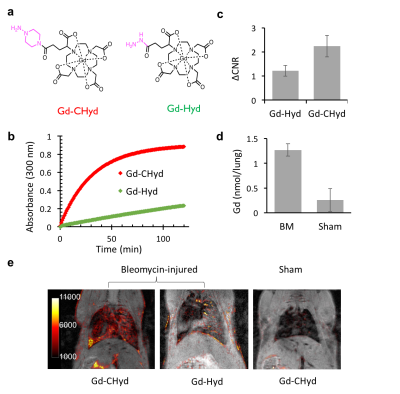 |
51 | Allysine-targeting gadolinium-based MRI probes for imaging lung fibrogenesis
Eman Akam, Nicholas Rotile, Iris Zhou, Eric Abston, Peter Caravan
There is an enormous unmet medical need for non-invasive methods to assess lung fibrosis that can distinguish between active disease and stable scar. Here, we report on a gadolinium-containing contrast agent Gd-CHyd that targets fibrogenesis (active fibrosis) by undergoing a condensation reaction with allysine, an abundant aldehyde motif on fibrosing tissue. This probe reacts with aldehydes at a rate that is an order of magnitude faster than the parent probe Gd-Hyd. This faster reactivity leads to higher accumulation of the probe in the lungs of bleomycin treated mice (mouse model of lung fibrosis) and two-fold contrast enhancement relative to Gd-Hyd.
|
|
4256. 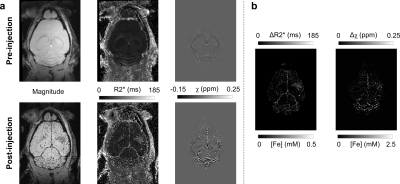 |
52 | Toward in vivo quantification of microparticles of iron oxide targeting cerebrovascular inflammation
Jérémie Fouquet, Dina Sikpa, Renat Sibgatulin, Andreas Deistung, Martin Krämer, Luc Tremblay, Karl-Heinz Herrmann, Réjean Lebel, Jürgen Reichenbach, Martin Lepage
Microparticles of iron oxide (MPIOs) can be detected by MRI with high sensitivity. This has recently led to their utilization as efficient contrast agents for molecular imaging or cell tracking. We present first steps toward in vivo quantification of a targeted MPIO that is widely used for inflammation imaging. These steps include 1) relaxivities and molar susceptibility measurements on a phantom, 2) in vivo estimation of the concentration of inflammation-specific MPIOs in a mouse model of cerebrovascular inflammation and 3) acquisition of ex vivo images that validate the results obtained in vivo.
|
|
4257. 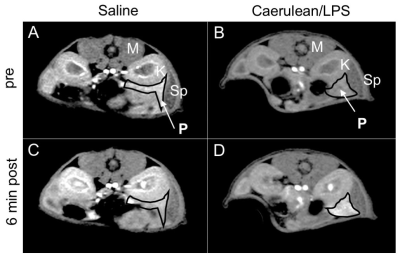 |
53 | Molecular MR imaging of Acute Inflammation using a Biochemically Responsive Iron-Based Contrast Agent
M Veronica Clavijo Jordan, Ian Ramsay, Huan Wang, Caravan Peter, Eric Gale
The redox active MRI contrast agent Fe-PyC3A is shown to provide strong, selective contrast enhancement of acutely inflamed pancreatic tissue in a murine model. Fe-PyC3A is administered in the weakly contrasting Fe(2+) oxidation state but is converted to the 15-fold more strongly contrasting Fe(3+) state in the presence of reactive oxygen species (ROS). Fe-PyC3A does not provide contrast enhancement of normal pancreas, but provides significant contrast enhancement of inflamed pancreas. Pancreatic enhancement correlates tightly with activity levels of the pro-inflammatory biomarker myeloperoxidase. This is the first example of using metal ion redox for MR imaging of pathologic change in vivo.
|
|
4258 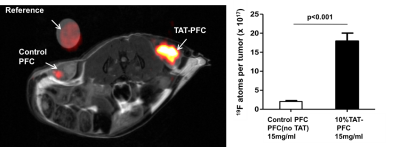 |
54 | TAT-functionalized perfluorocarbon nanoemulsion for 19F imaging of CAR T cells in vivo. Video Permission Withheld
Dina Hingorani, Fanny Chapelin, Emma Stares, Stephen Adams, Hideho Okada, Eric Ahrens
To improve the utility of 19F MRI to detect lymphocytes in vivo, we looked into strategies to increase cell loading via the use of
|
|
4259. 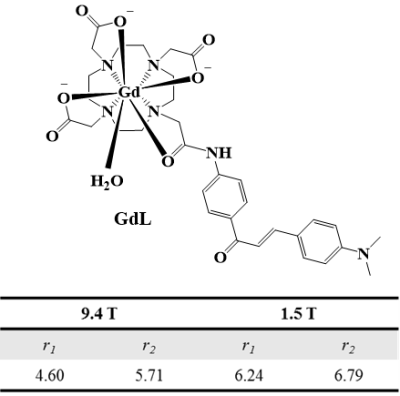 |
55 | Beta-amyloid specific in vivo MR imaging with chalcone conjugated gadolinium complex.
Ah Rum Baek, Hee-Kyung Kim, Garam Choi, Soyeon Kim, Bo Kyung Sung, Byeong Woo Yang, Heejin Seo, Sunghwan Hwang, Kamrul Islam, Hoesu Jung, Taekwan Lee, Yongmin Chang
A new gadolinium complex conjugated with chalcone derivative (GdL) shows beta-amyloid specific enhancement in vivo MR imaging. The enhanced region in MR image matched well with fluorescence imaging of beta-amyloid plaque, which was stained by thioflavin S. The difference of signal enhancement between GdL and Gadovist in beta-amyloid oligomer supported that GdL has specificity on beta-amyloid. In addition, GdL shows considerable relaxivities even at high field 9.4 T (r1 = 4.60, r2 = 5.71 mM-1s-1) and comparable kinetic stability compared with commercial MRI agents.
|
|
| 4260. |
56 | Development of a novel theranostic NPs composed of Fe3O4, Trastuzumab and indocyanine green for diagnosis and treatment of HER-2 positive breast cancer
Xiaojun Luo, Chunwu Zhou, Jing Li, Lizhi Xie
Superparamagnetic iron oxides can be used as contrast agents for MR T2-weighted imaging. We created multifunctional nanoparticles based on Fe3O4, Trastuzumab and indocyanine green (ICG) to target HER2 positive breast cancer cells in vitro and vivo. Firstly, internalization was assessed on HER-2 positive breast cancer SK-BR-3 cells by transmission electron microscopy (TEM). Furthermore magnetic resonance imaging (MRI) and fluorescence imaging were used to examine the biodistribution and its targeting effect in vivo. Additionally, photothermal therapy (PTT) was further evaluated to examine the treatment effect of NPs. As a result, Fe3O4-trastuzumab-ICG have shown great potential to become an effective multifunctional imaging agent and a tool for photothermal therapy for HER-positive breast cancer.
|
|
4261. 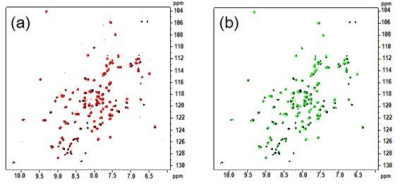 |
57 | A noninvasive T1-weighted MR tool for tracking of vicinal thiols motif of thioredoxin protein in live cells Presentation Not Submitted
Hyeonseung Lee, Hyun Min Kim, Jongeun Kang, Sankarprasad Bhuniya, Kwan Soo Hong
We have synthesized a couple of new MRI contrast agent for recognition of cellular vicinal thiols motif protein thioredoxin.
|
|
4262. 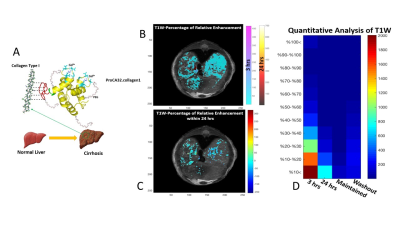 |
58 | Quantitative Time-dependent Mapping of Liver Cirrhosis Heterogeneity with A Protein-based MRI Contrast Agent
Maysam Nezafati, Mani Salarian, Jenny Yang, Shella Keilholz
This work is focused on quantitative and qualitative analysis of the spatial and time-dependant heterogeneity of liver cirrhosis using a novel protein-based MRI contrast agent which targets collagen type I.
|
|
4263. 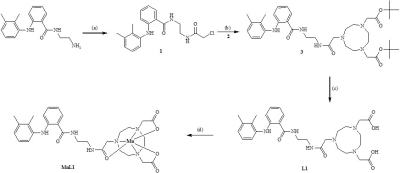 |
59 | Macrocyclic Manganese (II) Complex of Mefenamic acid (MA) Conjugate as an Inflammation Targeting MRI Contrast Agent
Md Kamrul Islam, Hee-Kyung Kim, Soyeon Kim, Bo Kyung Sung, Garam Choi, Ah Rum Baek, Sunghwan Hwang, Byeong Woo Yang, Heejin Seo, Hoesu Jung, Taekwan Lee, Yongmin Chang
The purpose of the present study is to design and synthesis of novel macrocyclic Mn2+ complex as an alternative to the well-established Gd3+ based chelates for use as an inflammation targeting MR imaging agent. This new complex exhibits higher r1 relaxivity (2.32 mM−1 s−1) than clinically approved Mn-DPDP® (1.6 mM−1 s−1) at 4.7 T. T1-weighted MR coronal images display strong signal enhancement in liver, heart, gallbladder and kidney. In an inflammatory mouse model, it shows greater inflammatory tissues detection with in a clinical dose.
|
|
4264. 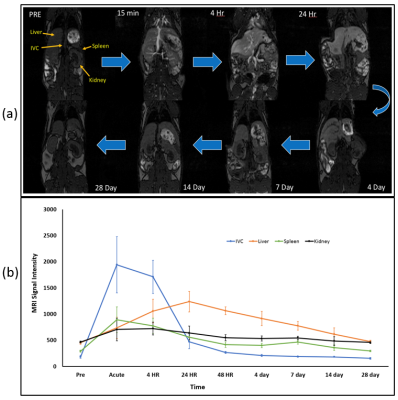 |
60 | Determination of the fate of intravenously administered Gd(III)DOTA-DSPE-based liposomal contrast agent in a mouse model
ERIC TANIFUM, Conelius Ngwa, Laxman Devkota, Andrew Badachhape, Ketan Ghaghada, Prajwal Bhandari, Igor Stupin, Mayank Srivastava, Ananth Annapragada
Small molecule conventional gadolinium (Gd) present major safety concerns including nephrogenic systemic fibrosis (NSF) and brain accumulation. Liposomal Gd(III)DOTA-DSPE conjugate exhibit high relaxivity at clinically-relevant MR field strength, and enables molecular MR imaging mice. We report herein an investigation on the pharmacokinetics, bio-distribution and clearance of a liposomal-Gd agent in mice over a period of 28 days by T1-weighted MR imaging and ICP-MS analyses. Results show no significant skin or brain accumulation, suggesting NSF and brain accumulation concerns may be unlikely with such agent.
|
|
4265. 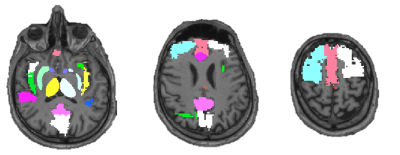 |
61 | A Predictive Model for Chronic Low Back Pain Objective Diagnosis Exploiting Multi-Modal Brain [11C]-PBR28 PET/MR Radiomic Features
Angel Torrado-Carvajal, Daniel Albrecht, Ken Chang, Andrew Beers, Oluwaseun Akeju, Minhae Kim, Courtney Bergan, Dunkan Hodkinson, Robert Edwards, Yi Zhang, Jacob Hooker, Vitaly Napadow, Jayashree Kalpathy-Cramer, Marco Loggia
Chronic pain affects more than 100 million individuals in the United States alone. However, our ability to diagnose and properly treat pain disorders is currently limited, including due to the lack of reliable biomarkers. In this work, we present a predictive model for the classification of chronic low back pain (cLBP) patients using multi-modal brain [11C]-PBR28 PET/MR radiomic features extracted from structural, functional, and molecular imaging. Our results suggest that a PET/MR classifier (RFPET/MR) performs better than single-modality classifiers (RFPET and RFMR) for AUC (p’s<0.01), accuracy (p’s<0.01), sensitivity (p’s<0.05), and specificity (p’s<0.01), highlighting the power of multi-modal over single-modality imaging.
|
|
4266. 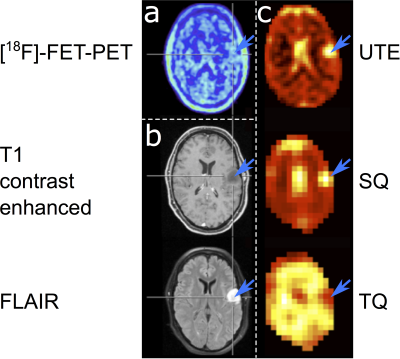 |
62 | 18F-Fluoroethyltyrosine PET and Multiple Quantum Filtered Sodium MRI in Cerebral Gliomas
Wieland Worthoff, Aliaksandra Shymanskaya, Philipp Lohmann, Karl-Josef Langen, N. Jon Shah
[18F]-FET-PET and sodium MRI were carried out on a cohort of patients with untreated cerebral gliomas. It is shown that the results from multiple quantum filtered sodium MRI using the enhanced SISTINA sequence are related to IDH mutational status in contrast to [18F]-FET-PET, thus providing the diagnostic potential to predict the genetic profile of gliomas.
|
|
4267. 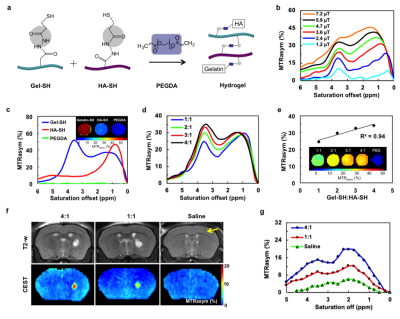 |
63 | Monitoring the Biodegradation of Implanted Hydrogel Cell Scaffolds using CEST MRI
Wei Zhu, Chengyan Chu, Shreyas Kuddannaya, Yue YUan, Piotr Walczak, Anirudha Singh, Xiaolei Song, Jeff Bulte
Scaffolding cells with hydrogels is a promising strategy to treat many tissue injuries and diseases. Observing hydrogel degradation is essential as it correlates to the cell release from the hydrogel. We monitored implanted hydrogel degradation using CEST MRI, with validation using two-color in vivo near-infrared imaging. An excellent correlation was found between these two methods, with gelation as the major decomposing component. The results demonstrate that CEST MRI can serve as a robust tool for monitoring hydrogel degradation in vivo.
|
|
4268. 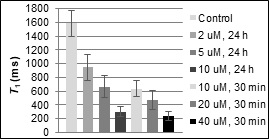 |
64 | An efficient cell-permeable T1 contrast agent for labeling and tracking human embryonic stem cells on MRI
Inga Haedicke, Sadi Loai, Hai-Ling Cheng
Human embryonic stem cells (hESCs) are pluripotent and, thus, have enormous potential as therapeutic cells in regenerative medicine. Non-invasive tracking of transplanted cells is critical for advancing cell-based therapies. MRI has emerged as an important technique for monitoring the fate of transplanted cells. However, conventional cellular MRI uses superparamagnetic iron oxide nanoparticles (SPIOs) that have limited specificity. To improve specificity, we developed a highly efficient, cell-permeable T1 agent for labeling hESCs without affecting cell viability, proliferation, or function. MR imaging of transplanted hESCs demonstrates sensitive detection of labeled cells in vivo.
|
|
4269.  |
65 | Dysprosium complexes encapsulated apoferritin T2 MRI contrast agent for ultra-high field MRI
Hee-Kyung Kim, Ahrum Baek, Sunghwan Hwang, Soyeon Kim, Garam Choi, Bo Kyung Sung, Byeong Woo Yang, Heejin Seo, MD. Kamrul Islam, Hoesu Jung, Taekwan Lee, Yongmin Chang
Apo[Dy(DO3A-ph-NH2)] is synthesized according to the precede literature. The absorbance is changed at 300-400 nm after encapsulation of Dy(DO3A-ph-NH2), and we confirmed the morphology of Dy(DO3A-ph-NH2) encapsulated protein with TEM image. The final concentration of paramagnetic composition is calculated by ICP. The relaxivities of Dy(DO3A-ph-NH2) encapsulated protein at various external fields (3 - 15.2 T) are considerably increased, and also r2/r1 ratios are increased up to 55 at 15.2 T.
|
|
4270 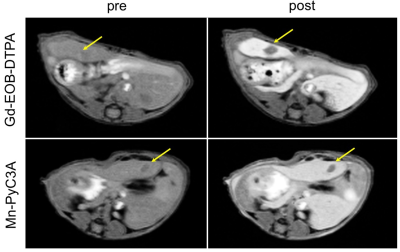 |
66 | Liver Distribution and Delayed Phase Liver Enhancement using Mn-PyC3A Video Permission Withheld
Derek Erstad, Ian Ramsay, Bryan Fuchs, Kenneth Tanabe, Peter Caravan, Eric Gale
Mn-PyC3A was rationally designed as a Gd-free alternative to commercially available MRI contrast agents. Quantification of Mn excretion using rats shows that the agent is efficiently eliminated with a fractional clearance that is 85% renal and 15% hepatobiliary. Based on the substantial fractional hepatobiliary excretion, we hypothesized that Mn-PyC3A would provide delayed, liver specific contrast enhancement that can be used to identify liver tumors. Mn-PyC3A was demonstrated to provide delayed phase liver enhancement that rendered liver tumors conspicuously hypointense in a murine model of colorectal metastasis.
|
|
4271.  |
67 | Micelles-like Biodegradable conjugates as Biocompatible MRI Contrast Agents for Advanced Imaging of Tumor and Angiography
Qiang Luo, Haonan Li, Kui Luo, Qiyong Gong
To improve the contrast enhancement of solid tumor, we prepared enzymes responsive biodegradable micelles-like agents (MpH-DOTA-Gd), and the HMPA based micelle-like polymeric MR contrast agents provided a possibility of selectively great contrast in MR imaging of tumor and angiography.
|
|
4272. 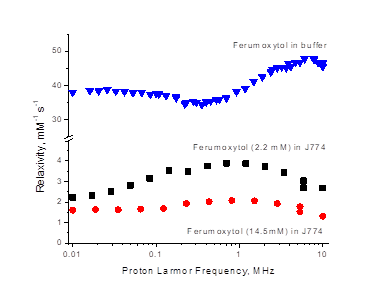 |
68 | In vivo Fast Field Cycling Relaxometry reports on the extra- and intracellular localization of iron oxide particles in tumour mice models.
Simonetta Geninatti Crich, Maria Ruggiero, Simona Baroni, Smeralda Rapisarda, Silvio Aime
A new sensitive, non invasive, imaging methods capable of a quantitative detection of Tumour Associated Macrophages (TAM) is herein proposed. The method is based the use Fast Field Cycling (FFC) relaxometers to assess the localization of ferumoxytol in TAM in melanoma tumours. The observed 1/T1 NMRD profiles appear highly dependent on the intra or extra cellular localization of the NPs thus allowing an unambiguous TAM quantification.
|
|
4273.  |
69 | Fluorous-metal chelate for sensitive 19F MRI paramagnetic nanoemulsion cell labels
Stephen Adams, Amin Haghighat-Jahromi, Chao Wang, Wenlian Zhu, Hongyan Xu, Eric Ahrens
Fluorine-19 MRI is a cellular imaging approach enabling quantitative ‘hot-spot’ imaging with no background. The utility of 19F-MRI to detect inflammation and cell therapy in vivo could be expanded by improving the intrinsic sensitivity of the probe by molecular design. We describe a small molecular weight fluorinated metal chelate (SALTAME) based on a salicylidene-tris(aminomethyl)ethane core, with solubility in perfluorocarbon (PFC) oils. SALTAME additive to nanoemulsion is a potent accelerator of 19F T1 and increases the image sensitivity per time with signal averaging. We assessed the biocompatibility, potential 19F signal enhancement and use for detecting inflammation macrophages in mice in vivo.
|
|
4274.  |
70 | Parahydrogen induced hyperpolarization of [1-13C] pyruvate for metabolic imaging in cancer research
Shingo Matsumoto, Neil Stewart, Yuka Fukue, Hiroshi Hirata
13C-labeled pyruvate is a clinically available key tracer for hyperpolarized 13C metabolic MRI study. An automated hyperpolarizing system of [1-13C]pyruvate using a low-cost parahydrogen induced polarization (PHIP) with side-arm hydrogenation (SAH), in which hyperpolarization is initially induced to the parahydrogen derived two 1Hs on unsaturated pyruvate precursor followed by the polarization transfer to a 13C of pyruvate, was developed. Magnetic field cycling process for 1H-to-13C polarization transfer process was optimized by the experimentally determined J-coupling network of pyruvate precursor and quantum chemical simulation, and its possible applications for cancer research are investigated in tumor-bearing mouse model.
|
|
4275. 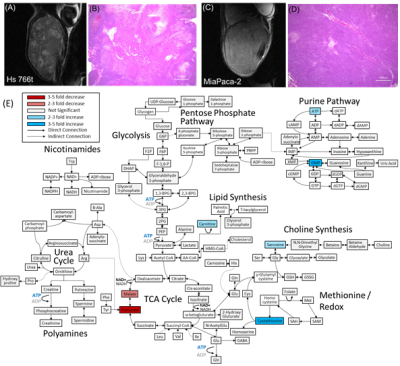 |
71 | Distinguishing Closely Related Pancreatic Cancer Subtypes by Glucose Metabolic Imaging Using 13C-MRS without Hyperpolarization
Shun Kishimoto, Jeffrey Brender, Shingo Matsumoto, Tomohiro Seki, Nobu Oshima, Hellmut Merkle, Galen Reed, Albert Chen, Jan Ardenkjaer-Larsen, Jeeva Munasinghe, Keita Saito, Kazu Yamamoto, Peter Choyke, James Mitchell
Metabolic differences both between patients and within the tumor itself can be an important determinant in cancer treatment outcome; however, methods for determining these differences non-invasively in vivo have been lacking. Using pancreatic ductal adenocarcinoma as a model, we demonstrate that xenografts with a similar genetic background can be distinguished by differing rates of glucose metabolism, which can be imaged by 13C glucose without hyperpolarization using a newly developed technique for noise suppression. Using this method, cancer subtypes that appear similar in mass spectrometry tissue biopsies and hyperpolarized MRI pyruvate metabolism measurements can be easily distinguished.
|
Digital Poster
| Exhibition Hall | 16:45 - 17:45 |
| Computer # | |||
4276. 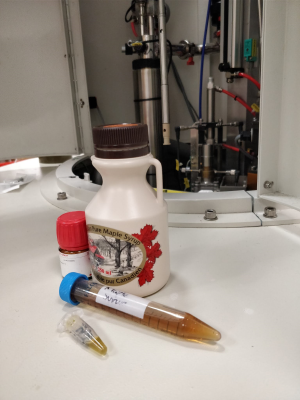 |
76 | HyperMaple: Maple Syrup as a Glassing Agent for DNP Sample Preparation
Justin Lau, Liam Young, Tony Zhou, Andrew Tyler, Jack Miller, Damian Tyler
Certain compounds require a glassing agent to be hyperpolarized for dynamic nuclear polarization experiments. We propose here the novel use of Canadian maple syrup, a delicious, hypoallergenic, and readily available concentrated sugar solution, as an alternative to conventional glassing agents such as dimethyl sulfoxide and glycerol, and have demonstrated its utility in hyperpolarizing [13C]urea.
|
|
4277. 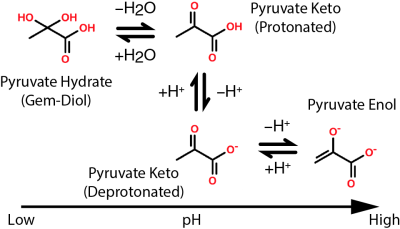 |
77 | Pyruvate keto-enol tautomerization and its potential impact on apparent pyruvate T1
Justin Lau, Liam Young, Jack Miller, Christopher Rodgers, Damian Tyler
Pyruvic acid is the most commonly studied metabolic agent for dynamic nuclear polarization. In aqueous solution, pyruvic acid can exist in three forms: hydrate (gem-diol), keto, and enol. The composition depends on pH. This study investigates the differences in longitudinal relaxation properties of the three tautomers with the objective of further understanding the factors contributing to the apparent T1 of pyruvic acid.
|
|
4278. 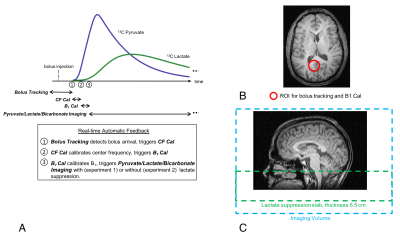 |
78 | Investigating Pre-Saturation of Inflowing Lactate for Improving Human Hyperpolarized 13C-Pyruvate Brain Studies
Jeremy Gordon, Shuyu Tang, Hsin-Yu Chen, Daniel Vigneron, Peder Larson
Dissolution dynamic nuclear polarization has enabled real-time metabolic imaging in both pre-clinical and clinical research applications. However, pre-clinical studies have provided evidence that inflowing metabolites can bias measurements in a number of organs. In this work, we explored the impact of inflowing lactate spins on quantitative hyperpolarized pyruvate 13C MRI of the human brain in a healthy volunteer. We provide evidence in a healthy volunteer that by pre-saturating inflowing lactate to address this confounding factor, kPL values in the brain were reduced by ~15%. Further studies will increase the sample size to better characterize this effect.
|
|
4279. 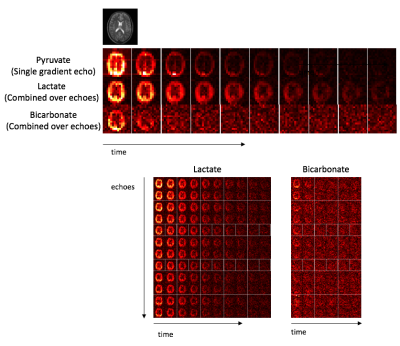 |
79 | An Optimized GRASE Sequence for Preclinical and Human Hyperpolarized 13C Imaging
Shuyu Tang, Jeremy Gordon, Peng Cao, Robert Bok, Daniel Vigneron, Peder Larson
An optimized GRASE sequence was developed for dynamic hyperpolarized 13C Imaging and demonstrated the feasibility for human brain research. The multi-echo signal can either be used to encode a 3D volume or as a 2D multi-echo approach to increase SNR or estimate T2. Varied crusher gradients were investigated to reduce the loss of longitudinal hyperpolarized 13C magnetization.
|
|
4280. 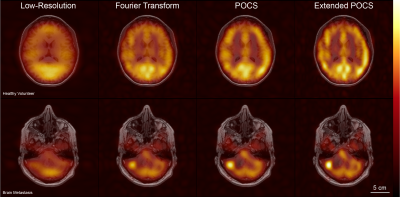 |
80 | Partial Fourier Reconstruction of Hyperpolarized 13C EPI in the Human Brain
Benjamin Geraghty, Casey Lee, Albert Chen, Nadia Bragagnolo, William Perks, Hany Soliman, Charles Cunningham
Asymmetric in-plane k-space sampling of EPI can reduce the minimum achievable TE in hyperpolarized 13C with spectral-spatial radio frequency pulses, thereby reducing T2* weighting and signal-losses. Partial Fourier image reconstruction exploits the approximate Hermitian symmetry of k-space data and can be applied to asymmetric data sets to synthesize unmeasured data. Here we present the results of applying partial Fourier image reconstruction from hyperpolarized [1-13C]pyruvate scans in human brain. A quantitative evaluation of image sharpness using no-reference image quality assessment agreed with a perceived improvement in contrast and resolution.
|
|
4281. 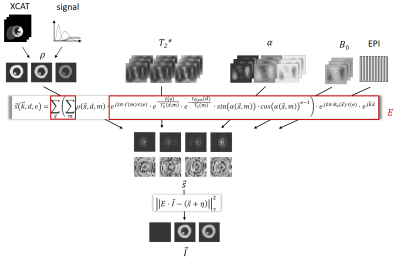 |
81 | Limits of Kinetic Modeling for Myocardial Infarction and Border Zone Detection Using Hyperpolarized 13C Magnetic Resonance Imaging
Julia Traechtler, Maximilian Fuetterer, Sebastian Kozerke
Kinetic modeling of hyperpolarized [1-13C]-pyruvate imaging allows quantification of cardiac metabolism. In this work, SNR is identified as a limiting factor for the detection of focal lesions and border zones with hyperpolarized 13C imaging under typical in-vivo conditions. Moreover, limits are determined with respect to SNR and resolution requirements. Based on calculated maps of kinetic conversion rates, infarcted areas with transmuralities ≥ 33% are distinguishable from remote myocardium even at a modest resolution of 10mm, while altered metabolism in the border zone (area-at-risk) is not detectable, even at higher resolutions of 5mm.
|
|
4282. 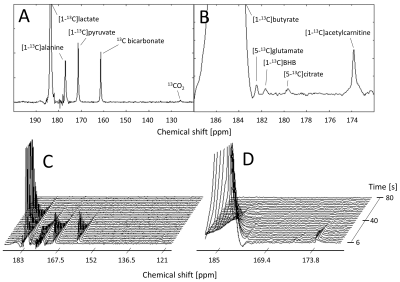 |
82 | Hyperpolarized metabolic imaging with high SNR in vivo using low volume photo-induced nonpersistent trimethylpyruvic acid radicals
Lionel Arn, Andrea Capozzi, Jessica Bastiaansen
Recently it was demonstrated that UV irradiation of trimethylpyruvic acid (TMP) generates nonpersistent radicals with narrow electron spin resonance linewidth. TMP however has never been used to hyperpolarize 13C substrates to study in vivo metabolic processes, and relatively large volumes of TMP were needed to generate high nonpersistent radical concentrations. The aim of this study was to increase the nonpersistent radical yield in TMP-doped [1-13C]lactic acid, [1-13C]butyric acid and 13C glucose preparations to achieve high polarization levels. In vivo metabolism was measured with signal levels similar to that of persistent radical preparations, demonstrating TMP as a promising nonpersistent radical for dissolution DNP and potential clinical translation.
|
|
4283. 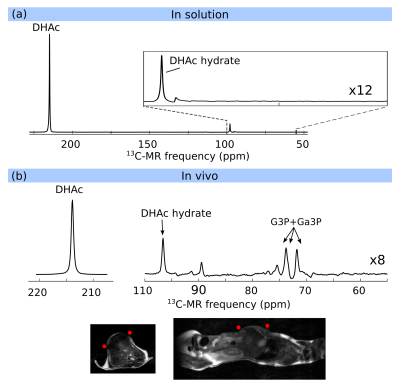 |
83 | Phenylglyoxylic acid as a generic UV-induced radical precursor to hyperpolarize 13C-labelled substrates for in vivo metabolic studies
Irene Marco-Rius, Tian Cheng, Adam Gaunt, Saket Patel, Felix Kreis, Andrea Capozzi, Alan Wright, Kevin Brindle, Olivier Ouari, Arnaud Comment
Photo-irradiation of phenylglyoxylic acid (PhGA) using visible light produces a non-persistent radical that, in principle, can be used to hyperpolarize any molecule. We show that PhGA can be used as a radical precursor to polarize photo-sensitive metabolic substrates (such as the gluconeogenic probe 13C-dihydroxyacetone) as well as 13C-glucose. We also present our preliminary DNP data obtained in PhGA-doped samples using a novel custom-built cryogen-free 7T/1.4K polarizer.
|
|
4284. 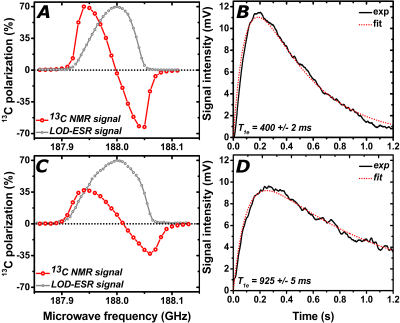 |
84 | Over 70% 13C polarization on [U-13C]glucose
Andrea Capozzi, Magnus Karlsson, Mathilde Lerche, Jan Henrik Ardenkjaer-Larsen
The undisputed usefulness in biomedical applications, the high carbon polarization (up to 70%) and the long relaxation time constant have made “neat [1-13C]pyruvic acid plus trityl” the most studied dissolution-DNP sample. Nevertheless, too often results valid for this particular preparation are considered to hold also for other trityl-based samples, limiting the potential of other biologically interesting substrates. In the present study we demonstrate that the sample composition and magnetic field affect the trityl ESR properties. A thorough optimization of the these parameters lead to a dramatic increase of [U-13C]glucose polarization from 37±4% to 69±3%, the highest value reported to date.
|
|
4285. 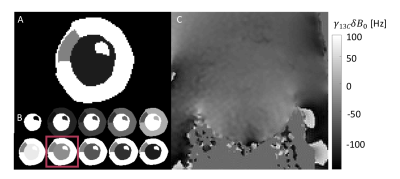 |
85 | Detectability of Local Lesions in the Heart using Echo Planar versus Spiral Hyperpolarized 13C Imaging
Andreas Dounas, Maximilian Fuetterer, Julia Traechtler, Sebastian Kozerke
Spiral and EPI are the most commonly used trajectories for imaging hyperpolarized 13C substrates. In this work, the two acquisition methods are compared with regard to B0 and T2* effects for typical parameter sets used for in vivo imaging of the heart. While Spirals exhibit higher SNR, EPI trajectories show higher effective resolution with standard gradient system performance. The relative differences in SNR and resolution between the two trajectories reduce with the availability of high-performance gradients.
|
|
4286. 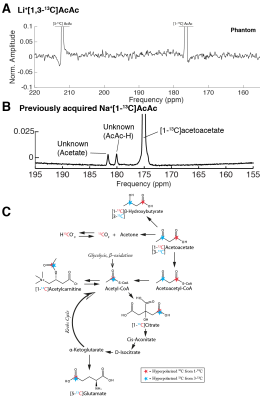 |
86 | Polarisation, T1 and Synthetic Impurities in Hyperpolarised Acetoacetate: Density Functional Theory to In Vivo Application
Belinda Ding, Justin Lau, Andrew Tyler, Kerstin Timm, Christopher Rodgers, Sarah Jenkinson, Brett Kennedy, Damian Tyler, Jack Miller
Alterations in ketone body metabolism are implicated in disease. Several studies have observed metabolism in hyperpolarised sodium acetoacetate, but as a hyperpolarised probe it has a short T1 (28s at 7T), limiting polarisation of 7-8%, and is often chemically impure as it spontaneously decarboxylates at neutral pH at 300K. We have studied selective deuteration of [1-13C] and [1,3-13C]acetoacetate together and evaluated the effect of salt solvation on hyperpolarisation in the discretised Borghini model of thermal mixing. Li+[2,2-2H2,1,3-13C2]acetoacetate is observed to have a higher limiting polarisation and substantially longer T1 than Na+[1-13C]acetocetate.
|
|
4287. 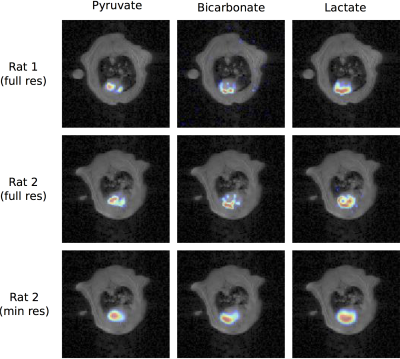 |
87 | A 3D HYBRID-SHOT SPIRAL FOR HYPERPOLARIZED 13 C IMAGING (3D-HYSS)
Andrew Tyler, Justin Lau, Vicky Ball, Kerstin Timm, Tony Zhou, Damian Tyler, Jack Miller
Spiral k-space trajectories are a powerful tool for in vivo 13C hyperpolarized cardiac MRI, however short readout durations limit the maximum resolution that single-shot spiral trajectories can achieve for a given field of view. This leaves the researcher with a choice at acquisition time, use a single-shot trajectory with poor spatial resolution or switch to a multiple-shot scheme with improved spatial resolution at the cost of degraded temporal resolution. We present a hybrid-shot spiral trajectory, which by compounding a single-shot and multiple-shot spiral, shifts this decision to analysis time.
|
|
4288. 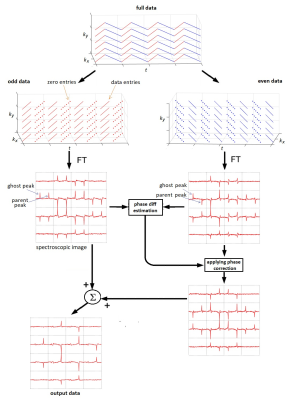 |
88 | Data-driven Nyquist ghost correction for hyperpolarized 13C EPSI and EPI
Abubakr Eldirdiri, Stefan Posse, Lars Hanson, Andreas Clemmensen, Andreas Kjær, Adam Hansen, Jan Henrik Ardenkjær-Larsen, Charles Cunningham
Echo-planar readout is often used in hyperpolarized imaging because of its rapid sampling of the k-space. This scheme, however, suffers from Nyquist ghosting artifacts. We present a data-driven approach to correct Nyquist ghosting in hyperpolarized 13C-EPSI and EPI . The method exploits the sparsity of the spectra in hyperpolarized 13C imaging spectroscopy, and estimates the phase discrepancies from the odd and even data in 13C-EPSI. The method was demonstrated in phantoms and in vivo. We show that it performs better than the 1H reference-based reconstruction, and it eliminates the need for reference scans, which may be an unnecessary source of error.
|
|
4289. 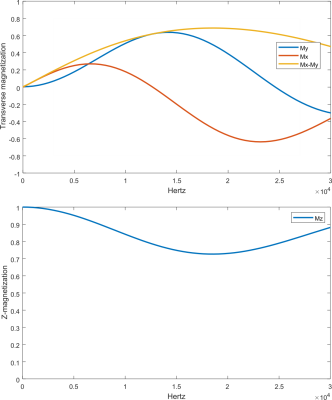 |
89 | Binomial Excitation for Detection of Hyperpolarized [2-13C]Dihydroxyacetone Metabolism
Mukundan Ragavan, Alan Carter, Daniel Downes, Anthony Giacalone, Keith Michel, James Bankson, Matthew Merritt
In this study, we have employed a simple binomial excitation pulse to follow metabolism of hyperpolarized [2-13C]dihydroxyacetone in perfused livers. We demonstrate the utility of binomial pulses in suppressing the hyperpolarized (HP) substrate resonance and maximizing metabolite signal intensities.
|
|
4290. 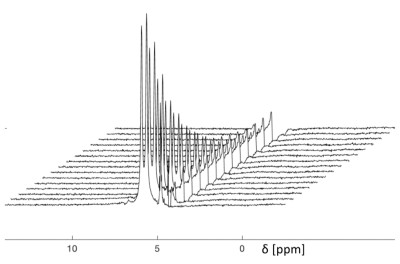 |
90 | Partial hyperpolarization transfer to protons in [15N2]urea
Felix Kreis, Alan Wright, Rachel Katz-Brull, Kevin Brindle
Direct observation of 15N hyperpolarization is limited by nitrogen’s low gyromagnetic ratio. We overcome this limitation here by transferring 15N hyperpolarization in [15N2]urea to spin coupled protons. The larger gyromagnetic ratio of the protons will increase the sensitivity of detection provided that there is not a significant loss of polarization during the transfer. We show that our polarization transfer pulse sequence, which has been modified for partial polarization transfer, is tolerant of B1 and centre frequency variations and can be used for dynamic spectroscopy and imaging measurements.
|
|
4291. 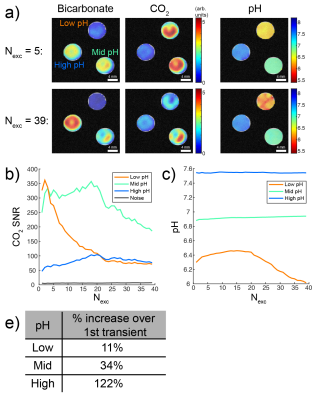 |
91 | Making the Transfer: Exploiting Hyperpolarized Bicarbonate-CO2 Exchange for Increased Signal-to-Noise pH Imaging
David Korenchan, Jeremy Gordon, Sukumar Subramaniam, Renuka Sriram, Peder Larson, Dan Vigneron, Robert Flavell, John Kurhanewicz
Hyperpolarized (HP) [13C]bicarbonate MR imaging can map pH in vivo, but images generally suffer from low CO2 signal-to-noise ratio (SNR). However, rapid bicarbonate-CO2chemical exchange can increase CO2 SNR via exchange-mediated polarization transfer. We exploit this phenomenon for HP [13C]bicarbonate imaging to boost CO2 SNR by 2.2-fold at pH 7.6, where CO2 SNR is lowest in the physiologic range, by acquiring and summing multiple transients. Tip angles and delays are chosen using a prioriknowledge of exchange rate to increase SNR while mitigating pH error. This approach can potentially improve imaging SNR in vivo for studying extracellular acidosis in cancer.
|
|
4292. 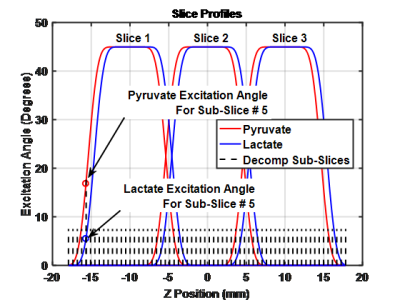 |
92 | Multi-Slice Correction for Metabolic Rate Quantification of Hyperpolarized Pyruvate
Christopher Walker, James Bankson
Due to the non-renewable nature of
|
|
4293. 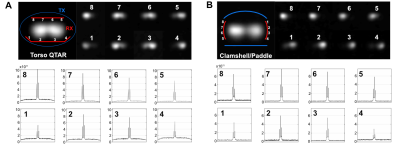 |
93 | Quadrature Transmit and Receive Array 13C RF Coil for Clinical Cardiac and Hepatic Imaging with Hyperpolarized 13C-Substrates
Jae Mo Park, Ralph Hashoian, Galen Reed, Albert Chen, Craig Malloy
A flexible torso 13C RF coil with quadrature transmit and 8-channel receive array that is designed for imaging cardiac and hepatic metabolism in humans was evaluated. B1+field homogeneity and SNR were measured using phantoms. The torso coil had improved SNR and larger spatial coverage as compared to the conventional clamshell/paddle array coils.
|
|
4294. 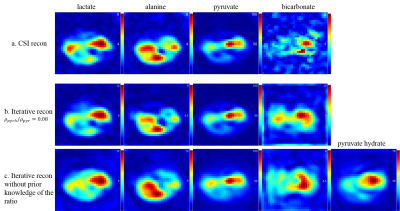 |
94 | Improving Hyperpolarized 13C Spiral Chemical Shift Imaging Using Model-Based Iterative Reconstruction and Prior Knowledge
Minjie Zhu, Dirk Mayer
A model-based iterative reconstruction algorithm for spiral chemical shift imaging (spCSI) of hyperpolarized 13C metabolites is implemented and compared to conventional CSI reconstruction. The iterative reconstruction utilizes the prior knowledge of 1) the off-resonance frequencies for each metabolite and 2) the common spatial distribution for pyruvate and pyruvate hydrate. The proposed method improves quantification of bicarbonate and reduces artifacts for pyruvate maps caused by
|
|
4295. 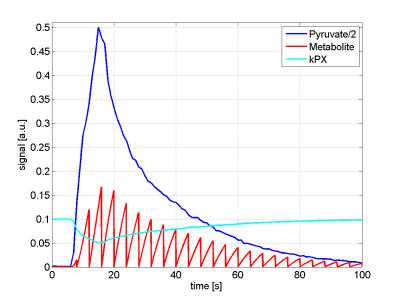 |
95 | Apparent metabolic exchange rate mapping using saturation-recovery acquisition and Michaelis-Menten modelling
Rolf Schulte, Esben Hansen, Uffe Kjaergaard, Marion Menzel, Christoffer Laustsen
Injecting high doses of hyperpolarised 13C pyruvate in vivo leads to saturation effects: more precursor will not increase the amount of downstream substrate, leading to errors when quantifying with the conventional two-site exchange model. Saturation effects can be modelled via a Michaelis-Menten kinetics, however requiring metabolic exchange rates measured at multiple time points as input. In this work we extend a previous saturation-recovery measurement to map apparent metabolic exchange rates taking saturation effects into account.
|
|
4296. 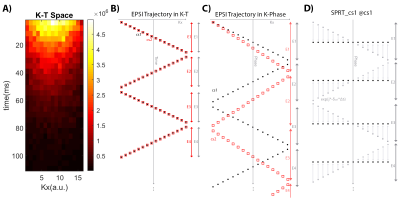 |
96 | Symmetry Preserved Rectilinear Transform(SPRT): Optimized Reconstruction of Echo Planar Spectroscopic Image for Hyperpolarized [1-13C]-Pyruvate
Zhan Xu, Joshua Niedzielski, Keith Michel, Christopher Walker, Samuel Einstein, James Bankson
A new reconstruction method, symmetry preserved rectilinear transform (SPRT) is proposed to remove the Nyquist ghost and chemical shift artifacts from symmetric echo-planar spectroscopic imaging (EPSI) data. For each metabolite in the spectrum, an additional phase term is added to reshape the zig-zag layout of k-t space samples into a rectilinear layout with all echoes parallel to each other in k-t space. SPRT can eliminate artifacts and significantly improve SNR.
|
|
| 4297. |
97 | Frequency calibration methods for the use of 13C spectral-spatial pulses in human brain
Mary McLean, James Grist, Fulvio Zaccagna, Frank Riemer, Basetti Madhu, Christoffer Laustsen, Rolf Schulte, Martin Graves, Kevin Brindle, Ferdia Gallagher
Spectral-spatial pulses demand accurate frequency setting, which is difficult for studies using hyperpolarized 13C substrates, as the calibration has to be performed prior to the injection of the labelled molecule. In this study we retrospectively analysed human 13C brain studies, comparing three methods of scan calibration: study date, external reference phantom, and 1H frequency. The latter method outperformed the other 2 by a large margin: the SD of differences (predicted minus actual frequency of pyruvate) was 11 Hz with 1H frequency, 39 Hz using study date, and 40 Hz when referenced to an external phantom.
|
|
4298. 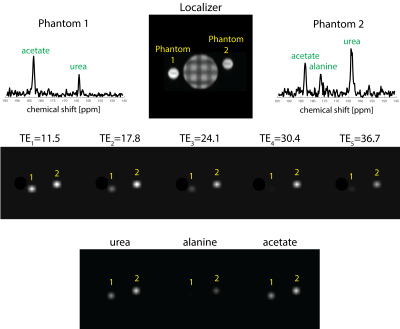 |
98 | Fast acquisition of hyperpolarized MR with Multi-echo EPI
Kofi Deh, Kristin Granlund, Kayvan Keshari
An EPI acquisition can efficiently acquire data, allowing multiple images to be acquired before the transverse signal decays due to T2*. These images (acquired at different echo times) can be reconstructed into images of individual species, as with Dixon or IDEAL. This approach can be used to efficiently acquire hyperpolarized data by limiting the number of excitations to preserve longitudinal magnetization for subsequent time points or enabling the use of larger flip angles for higher SNR. In this abstract, we demonstrate the feasibility of this approach with thermal phantoms (acetate, alanine, and urea) and with hyperpolarized phantoms (pyruvate and urea).
|
|
4299. 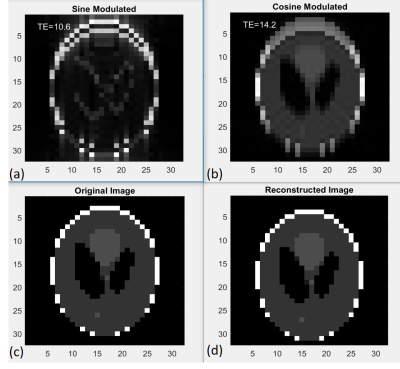 |
99 | A Quadrature Detection Technique to Resolve J-Modulated [2-13C]Lactate in Hyperpolarized [2-13C] Pyruvate Imaging
Keshav Datta, Daniel Spielman
For the imaging of hyperpolarized [2-13C]pyruvate, we propose a hybrid approach in which the closely spaced metabolic peaks of pyruvate, glutamate, citrate, acetoacetate, and acetyl-carnitine are measured using spectroscopic imaging, while the highly shifted [2-13C]Lactate peak is measured using selective excitation with a conventional fast imaging readout. We further demonstrate that a quadrature image reconstruction algorithm combining data from two fast imaging acquisitions, with the readout shifted by 1/2J, eliminates severe artifacts that normally arise when imaging a J-coupled system for which 1/J is comparable to the readout window.
|
|
4300. 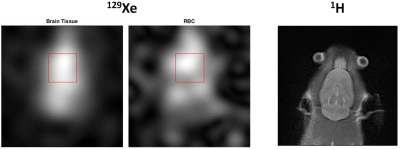 |
100 | Spiral-IDEAL for Time-Resolved Imaging of Hyperpolarized 129Xe Kinetics in the Rat Brain
Yonni Friedlander, Brandon Zanette, Marcus Couch, Andrea Kassner, Giles Santyr
Rapid, spectrally resolved imaging of 129Xe in the rat brain may allow for measurement of cerebral blood flow, as well as tissue characteristics such as relaxation rates and partition coefficient which may be useful for characterizing neurological disease or injury such as stroke. In this work, the feasibility of spiral-IDEAL for spectrally resolved 129Xe in the rat brain was demonstrated during steady state ventilation of a rat. With future improvements to the signal-to-noise ratio, it is proposed that spiral-IDEAL will allow for rapid, spectrally resolved imaging of the brain.
|
Digital Poster
| Exhibition Hall | 16:45 - 17:45 |
| Computer # | |||
4301. 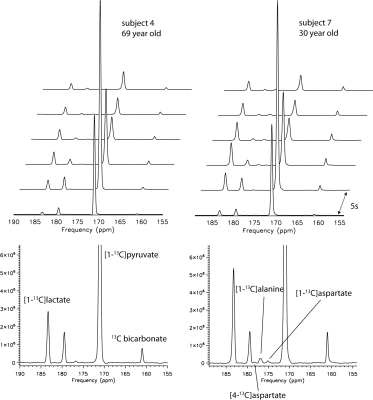 |
101 | Detection of pyruvate carboxylation and age related changes in glycolysis in human brain using hyperpoplarized 13C MR spectroscopy
Albert Chen, Casey Lee, Benjamin Geraghty, William Perks, Hany Soliman, Charles Cunningham
The feasibility of acquiring hyperpolarized 13C images from human brains following injections of HP [1-13C]pyruvate solution has been recently demonstrated. In this study, following each dynamic 3D volume 13C imaging acquisition (5 s temporal resolution), 13C spectroscopic data were acquired from a large slab through the brain. 13C pyruvate, lactate, alanine and bicarbonate were observed in all volunteer subjects. 13C aspartate was also detect in some of the subjects. Good inter-subject consistency in metabolite ratios as well as potential age related trend were observed in these data.
|
|
4302 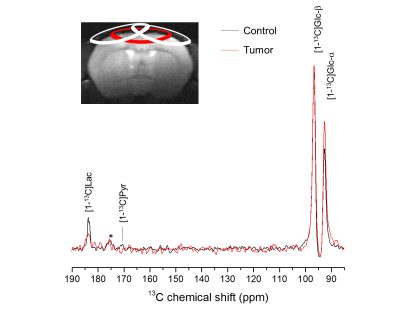 |
102 | Lactate production but not pool-size is altered in infiltrative mouse model of human GBM: a 1H MRS and hyperpolarized [2H7,13C6]D-glucose study Video Permission Withheld
Mor Mishkovsky, Olga Gusyatiner, Bernard Lanz, Irene Vassallo, Marie-France Hamou, Rolf Gruetter, Monika Hegi
Glioblastoma (GBM) is the most malignant primary brain tumor in adults. Aberrant glucose metabolism is considered a hallmark of cancer, via the so called ‘Warburg Effect’. MRS gives the access to study tumor metabolism. 1H MRS enables to quantify the steady state pool size and 13C MRS of hyperpolarized (HP) endogenous compounds provides real time metabolic information which is related to enzymatic activity. The aim of the present study was to examine whether changes in lactate production through glycolysis can be characterized using HP [2H7,13C6]D-glucose MRS, and if those correspond to changes in lactate pool size.
|
|
4303. 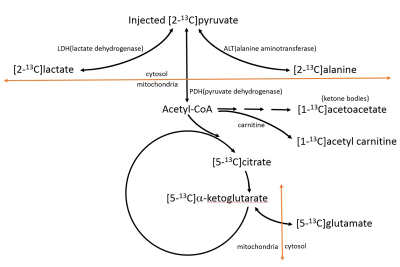 |
103 | In-Vivo Metabolism Differences of Multiple Body Parts using Hyperpolarized [2-13C]pyruvate Presentation Not Submitted
Jian-Xiong Wang
Hyperpolarized [2-13C]-pyruvate can assess multiple metabolic pathways within mitochondria to follow the 13C label beyond flux through PDH complex and investigate the incorporation of acetyl-coenzyme into different metabolic pathways. This study investigated metabolic products from [2-13C]-pyruvate and the differences of LDH and ATL process in heart, liver and kidney.
|
|
4304. 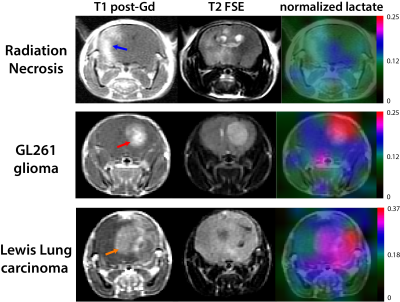 |
104 | Differentiating Radiation Necrosis from Brain Tumor Using Hyperpolarized Carbon-13 Metabolic MRI
Seulkee Kim, Biruk Birhanu, Daniela Pucciarelli, Chung-Man Moon, Jin Myung Choi, Shin Jung, Woong Yoon, Jean Nakamura, Ilwoo Park
The differentiation of recurrent tumor from radiation necrosis after radiation therapy remains often challenging in patients with brain tumor despite various advanced MR imaging techniques. The purpose of this study was to explore the feasibility of hyperpolarized 13C metabolic imaging in differentiating brain tumor from radiation necrosis. The lactate signal in radiation necrosis model was significantly lower than that in glioma and lung cancer metastasis. This suggests that the non-invasive characterization of real-time metabolism using this new neuroimaging method may be helpful for differentiating radiation-induced necrosis from recurrent brain tumors.
|
|
4305. 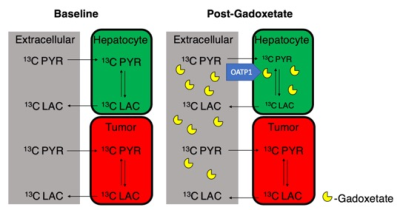 |
105 | Distinguishing metabolic signals of liver tumors from surrounding liver cells using hyperpolarized 13C MRI and Gadoxetate
Shubhangi Agarwal, Jeremy Gordon, Natalie Korn, Robert Bok, Cornelius Morze, Daniel Vigneron, John Kurhanewicz, Michael Ohliger
Hyperpolarized (HP) 13C MRI is a new technique that can assess the metabolic pathways in a variety of tumors. In this study, we show the ability of a gadolinium-based contrast agent (gadoxetate) to selectively suppress the HP metabolic signal arising from normal hepatocytes by altering the relaxation rates of metabolites 13C pyruvate and 13C lactate in order to evaluate the metabolic profile of tumors within the liver.
|
|
4306. 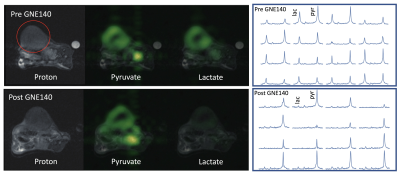 |
106 | Rapid Visualization of the Effects of Lactate Dehydrogenase Inhibition in Breast Cancer using Hyperpolarized Pyruvate
Cody Callahan, Manushka Vaidya, Olmo Sonzogni, Jocelin Pinto, Pankaj Seth, Gerburg Wulf, Aaron Grant
High rates of glycolysis in cancer can be targeted by inhibition of lactate dehydrogenase (LDH), the enzyme responsible for conversion of pyruvate into lactate. Hyperpolarized pyruvate was employed to assess the effects of GNE140, a recently developed inhibitor of LDH. Administration of GNE140 results in a sizable reduction in lactate signal within 30 minutes of administration.
|
|
4307. 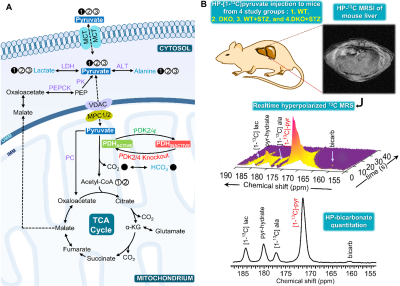 |
107 | Pyruvate dehydrogenase kinase knockout restores hepatic pyruvate oxidation in STZ-induced diabetic mice as revealed by hyperpolarized 13C-MRI
Gaurav Sharma, Alexander Funk, Cheng-Yang Wu, Xiaodong Wen, Nesmine Maptune, R. Wynn, Craig Malloy, A. Dean Sherry, David Chaung, Chalermchai Khemtong
Pyruvate dehydrogenase (PDH) kinase (PDK) modulates mitochondrial oxidative metabolism of carbohydrate by phosphorylating and inhibiting PDH. PDK is, therefore, an important therapeutic target for treating and managing metabolic diseases. This study evaluated
|
|
4308. 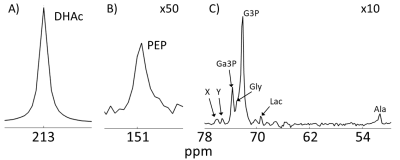 |
108 | Probing multiple metabolic pathways in vivo with 1H-decoupled 13C-MRS of hyperpolarized [2-13C]dihydroxyacetone
Irene Marco-Rius, Alan Wright, De-en Hu, Dragana Savic, Jack Miller, Kerstin Timm, Damian Tyler, Kevin Brindle, Arnaud Comment
Hyperpolarized [2-13C]dihydroxyacetone is a promising probe to investigate changes in glucose metabolism in different metabolic states, such as the alterations caused by diabetes or non-alcoholic fatty liver disease. Proton decoupled 13C-MR spectra of hyperpolarized [2-13C]dihydroxyacetone (DHAc) were acquired from the mouse liver using specialized spectral-spatial RF pulses. This optimized protocol for in vivo studies revealed metabolic products from three different metabolic pathways (gluconeogenesis, glycolysis and lipid synthesis) following the injection of this single hyperpolarized substrate. The metabolic products detected include glycerol 3-phosphate, glycerol, phosphoenolpyruvate, lactate, alanine, glyceraldehyde 3-phosphate and glucose 6-phosphate.
|
|
4309. 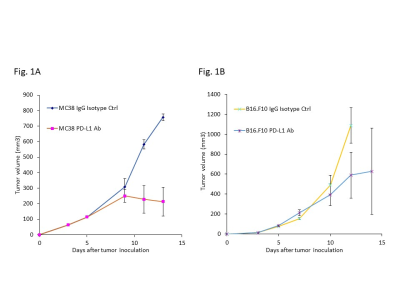 |
109 | Detecting early response to PD-L1 blockade by 13C MRI
Yu Saida, Tomohiro Seki, Kazu Yamamoto, Jeffery Brender, James Mitchell, Murali Krishna, Shun Kishimoto
This goal of this study is to detect metabolic changes using hyperpolarized 13C-MRI with [1-13C] pyruvate to evaluate the response to PD-L1 blockade treatment. Lactate/Pyruvate ratio tended to decrease in αPD-L1 antibody treated tumor in mouse model although not statistically significant. We will investigate capability of metabolic imaging to early response to immune checkpoint inhibitor.
|
|
4310. 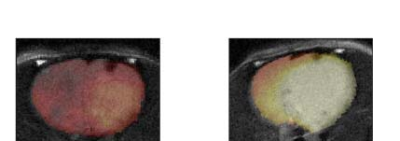 |
110 | Hyperpolarised [1-13C]pyruvate imaging of response to Bevacizumab
Richard Mair, Alan Wright, Kevin Brindle
13C chemical shift images were obtained from orthotopic rat models of glioblastoma prior to and following treatment with Bevacizumab. The resulting change in the hyperpolarized [1-13C]lactate/[1-13C]pyruvate ratio differed depending upon the model used. In U87 tumors the ratio increased and in patient-derived xenografts it decreased, with long term treatment of this latter model producing an invasive phenotype.
|
|
4311. 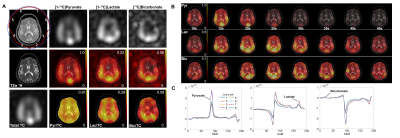 |
111 | Feasibility and Reproducibility of Imaging Brain Metabolism Using Hyperpolarized 13C Pyruvate in Humans
Jae Mo Park, Jeff Liticker, Crystal Harrison, Galen Reed, Thomas Hever, Junjie Ma, Richard Martin, Dirk Mayer, Ralph Hashoian, Christopher Madden, Marco Pinho, Craig Malloy
Human brain metabolism was investigated using hyperpolarized [1-13C]pyruvate and [2-13C]pyruvate in vivo. Each subject received hyperpolarized pyruvate intravenously with a 45-min interval between the injections. [1-13C]lactate and [13C]HCO3– were consistently detected from hyperpolarized [1-13C]pyruvate. [5-13C]Glutamate was measured from hyperpolarized [2-13C]pyruvate. The levels of production and relative intensities of the 13C-labeled metabolites were reproducible.
|
|
4312. 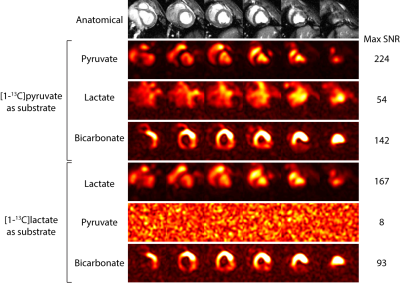 |
112 | Cardiac metabolic imaging using hyperpolarized [1-13C]lactate as a substrate
Angus Lau, Albert Chen, Charles Cunningham
The use of hyperpolarized [1-13C]lactic acid as a substrate for studying cardiac metabolism is attractive due to its high safety profile. 13C metabolite images were acquired following injection of hyperpolarized [1-13C]lactate in the porcine heart. The appearance of 13C-bicarbonate and absence of 13C-pyruvate in these images demonstrates rapid decarboxylation of pyruvate within the cardiac tissue.
|
|
4313.  |
113 | Effect of Opening the Blood-Brain Barrier with Focused Ultrasound on 13C Hyperpolarized Imaging in Rat Brain
Edward Hackett, Bingbing Cheng, Daniel Spielman, Kelvin Billingsley, Rajiv Chopra, Jae Mo Park
We examined how opening the blood-brain barrier (BBB) with focused ultrasound (FUS) pulses changes the uptake and metabolism of hyperpolarized [1-13C]pyruvate and [1-13C]glycerate in the brain. We observed larger amounts of metabolic products, lactate and bicarbonate, from hyperpolarized [1-13C]pyruvate in the brain region where FUS was applied. Moreover, increased [1-13C]glycerate uptake in the brain was detected after the FUS-induced BBB opening.
|
|
4314. 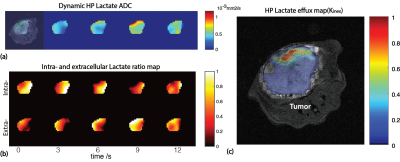 |
114 | Hyperpolarized 13C MRI Cellular Transport Modeling
Zijun Cui, Xucheng Zhu, Renuka Sriram, Zhen Wang, Peder Larson
Hyperpolarized (HP) 13C MRI is very appealing due to its potential in imaging the dynamic metabolic conversion and transport process. In this work, we tried to model the cellular transport process for dynamic HP 13C studies. Two highlights in this work are, (1) separating intra- and extracellular HP [1-13C] lactate based on dynamic HP 13C diffusion weighted imaging (DWI) technique, (2) extending standard kpl model to quantify cellular transport, with applications to cancer cell studies and cancer mouse studies.
|
|
4315 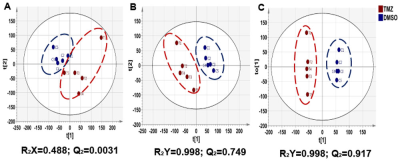 |
115 | Hyperpolarized 5-13C-Glutamate metabolism as a biomarker of IDH1 mutant glioma response to temozolomide therapy Video Permission Withheld
Elavarasan Subramani, Chloe Najac, Georgios Batsios, Pavithra Viswanath, Marina Radoul, Anne Marie Gillespie, Russell Pieper, Sabrina Ronen
The alkylating agent temozolomide (TMZ), previously used only in the treatment of high-grade glioblastoma, is now being considered for the treatment of low-grade glioma that are driven by mutations in the cytosolic isocitrate dehydrogenase 1 (IDH1) gene. However, early detection of response remains a challenge. 1H and hyperpolarized 13C magnetic resonance spectroscopy-based metabolic profiling of cells genetically engineered to express mutant IDH1 and treated with TMZ showed significant alterations in metabolites majorly related to the tricarboxylic acid cycle, and identified hyperpolarized 5-13C-glutamate metabolism as an indicator of response. These findings hold potential for assessing response of IDH1 mutant cells to TMZ therapy.
|
|
4316. 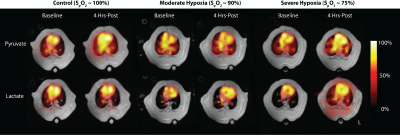 |
116 | Investigating the Impact of Hypoxia on Lung Metabolism using Hyperpolarized Carbon-13 MRSI
Mehrdad Pourfathi, Maurizio Cereda, Yi Xin, Stephen Kadlecek, Hooman Hamedania, Ian Duncan, Sarmad Siddiqui, Harrilla Profka, Kai Ruppert, Luis Loza, Faraz Amzajerdian, Ryan Baron, Tahmina Achekzai, Federico Sertic, Francisca Bermudez, Rahim Rizi
Systemic hypoxemia is a clinical hallmark of many lung pathologies, yet its impact on lung metabolism is not well understood. In this hyperpolarized carbon-13 MRI study, we seek to demonstrate the impact of both moderate and severe systemic hypoxemia on lung pyruvate metabolism using an imaging approach.
|
|
4317. 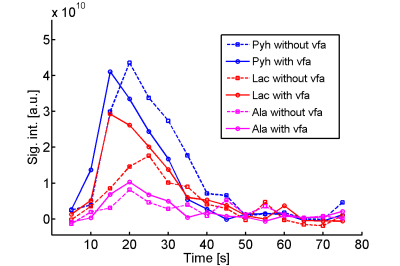 |
117 | Quantification of In Vivo Saturation Kinetics of Co-Polarized [2-13C]Pyruvate and [1,4-13C2]Fumarate in Rat Liver Using Dynamic 3D-Spiral CSI with Alternate Spectral Band Excitation
Maninder Singh, Aditya Jhajharia, Dirk Mayer
Dynamic metabolic imaging of co-polarized 13C-labeled pyruvate (Pyr) and fumarate (Fum) has shown great potential in characterizing multiple in vivo metabolic activities as demonstrated in recent animal models.1,2 Although in these studies, both the injected substrates and downstream metabolic product can be acquired over time at relatively high spatial resolution, robust quantification and metabolic modelling remains an active area of investigation. Also, the enzyme saturation effects that are routinely seen with commonly used doses of hyperpolarized substrates are not correctly captured using approaches such as metabolite ratios, time-to-peak of metabolic products, single exchange rate constants and by constant small-flip-angle excitation. Therefore, the goal of this study is to measure the saturation kinetics of various involved enzymatic processes using effective 90° excitation of the products at clinical field strengths. This work is an extension of our method developed for dynamic metabolic imaging of co-polarized mixture of [2-13C]Pyr and [1,4-13C2]Fum.2
|
|
4318. 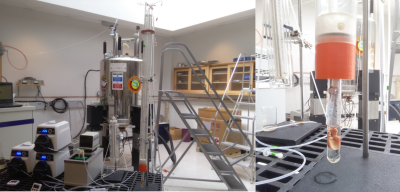 |
118 | Hyperpolarized Dihydroxyacetone Metabolism in the Mouse Liver Under Physiological Perfusion Conditions
Mukundan Ragavan, Alan Carter, Daniel Downes, Anthony Giacalone, Keith Michel, James Bankson, Matthew Merritt
Hyperpolarized [2-13C]dihydroxyacetone is a promising new molecular imaging agent that is sensitive to hepatic gluconeogenesis as well as glycolytic flux. Here, a physiological perfusion condition produces a metabolic profile in keeping with current understanding of hepatic metabolism, as compared to previous results from a model intended to strongly upregulate gluconeogenesis.
|
|
4319. 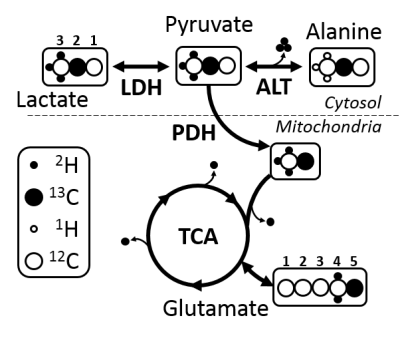 |
119 | Per-deuteration does not affect metabolic rates of hyperpolarized pyruvate in the isolated heart
Alexander Funk, Chalermchai Khemtong, Nesmine Maptue, Dean Sherry, Craig Malloy
The effects of deuteration in pyruvate on conversion to alanine and lactate, and flux into the TCA cycle were investigated by 13C NMR of tissue extracts from isolated hearts and studies of hyperpolarized [1-13C1, 3,3,3-2H3]pyruvate. No kinetic isotope effects were noted, but substantial exchange of water protons with deuterium was observed in alanine but not lactate or glutamate. Deuteration of pyruvate had little effect on metabolism in heart tissue, and the data suggests that formation of a Schiff base in alanine transaminase may occur without net interconversion of pyruvate and alanine.
|
|
4320. 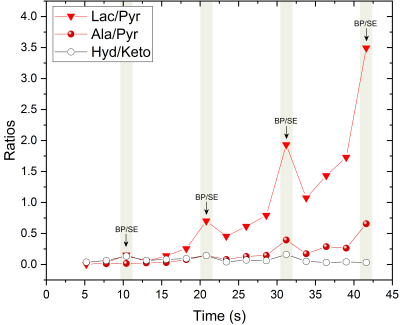 |
120 | Flow attenuation and saturation-recovery to discriminate between intracellular and inflowing species in renal hyperpolarized 13C MRS
Alice Radaelli, Rolf Gruetter, Hikari Yoshihara
Selective attenuation of signal from flowing hyperpolarized 13C spins can be used to enhance the fraction of signal from locally-produced metabolites. Here, we look at the effect of flow attenuation in the rat kidney on pyruvate metabolite ratios using an interleaved pulse-acquire/spin-echo+bipolar gradient acquisition scheme. With flow-sensitizing gradients applied, lactate- and alanine-to-pyruvate ratios increase as anticipated. Unexpectedly, the ratio of the hydrate and keto forms of pyruvate increases as well, suggesting a greater fraction of flowing keto-pyruvate. The increasing lactate signal fraction after saturation indicates that labelled circulating lactate becomes predominant over the course of the acquisition.
|
|
4321.  |
121 | Ex-vivo investigation of renal metabolic heterogeneity using hyperpolarized [1-13C]pyruvate MRI: a novel renal perfusion device
Christian Mariager, Esben Hansen, Sabrina Bech, Anders Munk, Mads Lyhne, Karsten Søberg, Peter Nielsen, Steffen Ringgaard, Christoffer Laustsen
The mammalian kidney is a complex organ, maintaining the water and nutrient balance of the body. Current knowledge of the essential functions, and the interplay with metabolic processes, are mainly derived from small animal experiments (uni-papilary kidneys) using invasive methods and lacking spatial resolution. The approach presented here addresses these limitations, by introducing a new MR compatible kidney perfusion device, enabling imaging of the underlying metabolic and functional patterns associated with the multi-papillary porcine kidney, better resembeling the human physiology.
|
|
4322. 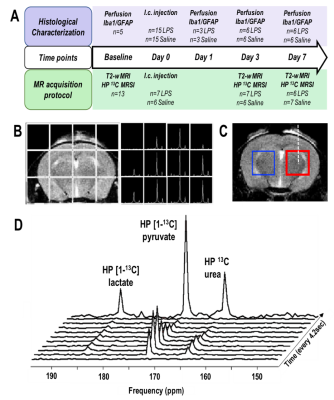 |
122 | Non-invasive detection of toxin-induced inflammation in the mouse brain using hyperpolarized 13C MRSI
Lydia Le Page, Caroline Guglielmetti, Brice Tiret, Myriam Chaumeil
In recent years, hyperpolarized (HP) 13C magnetic resonance spectroscopic imaging (MRSI) has shown promise in assessing neuroinflammation in the brains of mouse models of multiple sclerosis and traumatic brain injury. In this follow-up study, we used 13C MRSI of HP [1-13C] pyruvate/13C urea to assess neuroinflammation following intracranial injection of a toxin, namely lipopolysaccharide (LPS). A significantly elevated lactate:pyruvate ratio was observed in LPS-injected mice, and was associated with a significant increase in the presence of macrophages/microglia and astrocytes as assessed histologically. Our results demonstrate that HP 13C MRS has the sensitivity to assess toxin-induced changes in the brain.
|
|
4323. 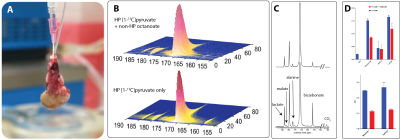 |
123 | Metabolism of hyperpolarized [1-13C]pyruvate in isolated perfused kidneys
Nesmine Maptue, Gaurav Sharma, Miriam Trigo, Alexander Funk, Thomas Hever, Xiaodong Wen, Craig Malloy, A. Dean Sherry, Chalermchai Khemtong
Kidney primarily oxidizes fatty acids and ketone bodies for ATP production but the substrate preference is altered in metabolic diseases. Renal metabolism is generally evaluated in kidney slices and in vivo. However, real-time metabolism has not been studied in isolated perfused kidneys where substrate availability and pharmacological interventions can be well-controlled. Here, we investigate pyruvate metabolism in isolated perfused rat kidneys by hyperpolarized 13C NMR. Results show that hyperpolarized 13C-pyruvate was rapidly metabolized in the kidneys and productions of 13C-bicarbonate, 13C-alanine, and 13C-lactate were detected. the utilization of pyruvate for energy production was confirmed by isotopomer analyses of tissue extracts.
|
|
4324. 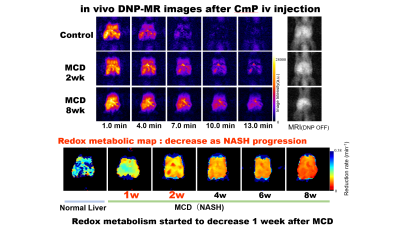 |
124 | Mitochondrial redox imaging of NASH animal model using in vivo Dynamic Nuclear Polarization MRI
Fuminori Hyodo, Ryosuke Nakata, Hinako Eto, Tomoko Nakaji, Masaharu Murata, Tatsuya Naganuma, Makoto Hashizume, Masayuki Matsuo
Currently available non-invasive imaging technologies, including CT, MRI and ultrasonography, are only able to assess fat accumulation in the liver. Therefore, these methods are not suitable for a precise diagnosis of NASH. The standard technique for diagnosing NASH, liver biopsy, has several drawbacks, such as the higher risk of complications that accompanies invasive procedures. Here, we demonstrated that in vivo mitochondrial redox metabolism was dramatically altered at an early stage, and NASH could be accurately diagnosed by in vivo dynamic nuclear polarization-magnetic resonance imaging, with carbamoyl-PROXYL as a molecular imaging probe. In addition, this technique was feasible for distinguishing between NAFLD and NASH. Our data reveal a novel method for monitoring the dynamics of redox metabolic changes and assessing the efficacy of therapeutic agents in NAFLD/NASH.
|
|
4325. 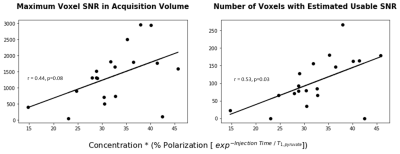 |
125 | Research Polarizer Quality Control Metrics and Resulting SNR in Human Prostate Cancer Patients
Natalie Korn, Jeremy Gordon, Justin Delos Santos, Hsin-Yu Chen, Peder Larson, Daniele Mammoli, Robert Bok, Mark VanCriekinge, Jim Slater, Rahul Aggarwal, Matthew Cooperberg, Lynn Delos Santos, Jeffry Simko, Susan Noworolski, Daniel Vigneron, John Kurhanewicz
The number of sites performing hyperpolarized [1-13C]pyruvate human studies is increasing every year. We relate metrics used in quality control (QC) of a polarized sample to traditional metrics of signal quality in vivo in 24 hyperpolarized human prostate exams. The QC metrics of injected volume and injection time are significantly correlated with the maximum [1-13C]pyruvate SNR in vivo (r=0.68, p<0.01; r=-0.48,p=0.05, respectively) and the number of voxels with estimated usable SNR (r=0.70, p<0.01; r=-0.59, p=0.01, respectively). These metrics have improved over the course of this trial with team coordination and can be improved at other sites beginning hyperpolarized human research.
|
Digital Poster
| Exhibition Hall | 16:45 - 17:45 |
| Computer # | |||
4326. 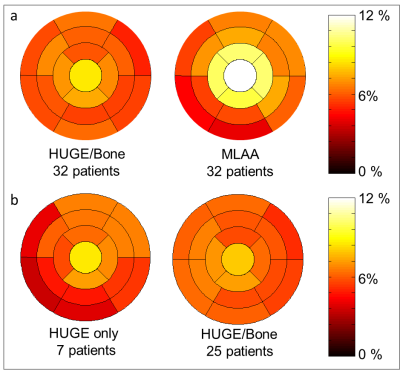 |
126 | Improved attenuation correction for cardiac 18F-FDG PET/MR hybrid imaging
Maike E. Lindemann, Felix Nensa, Harald H. Quick
The aim of this study was to evaluate and quantify the effect of improved attenuation correction including bone segmentation and truncation correction on 18F-FDG cardiac PET/MR imaging. Therefore, 32 cardiac patient data sets were reconstructed with different AC-maps and polar plots were generated and analyzed. The MR-based HUGE method for truncation correction combined with CT model-based bone segmentation resulted in a homogeneous 6% gain of PET signal across the myocardium compared to standard Dixon-VIBE imaging. The majority of observed AC-map artifacts did not significantly affect the quantitative assessment of the myocardium.
|
|
4327. 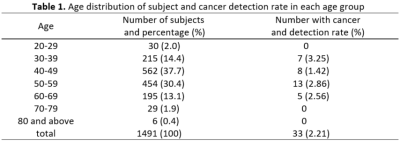 |
127 | Cancer screening using 18F-FDG PET/MR in asymptomatic subjects: a preliminary report Presentation Not Submitted
Mingxiang Sun, Mu Lin, Xiang Feng, Liling Peng, Xin Gao
This study was performed to evaluate the diagnostic value of PET/MR for cancer screening in asymptomatic subjects. 1491 subjects in total were enrolled in this study. 33 cases were diagnosed with malignant tumors, whereas 17 cases were correctly detected by PET/MR and 16 cases were detected by other methods. The overall detection rate of PET/MR in asymptomatic subjects was 1.14%, and the sensitivity, specificity, positive predictive value, and negative predictive value of PET/MR were 51.52%, 99.66%, 77.27% and 98.91%, respectively. As a cancer screening method, FDG PET/MR has great potentials to detect various kinds of tumors and should be beneficial to combine with other screening modalities.
|
|
4328. 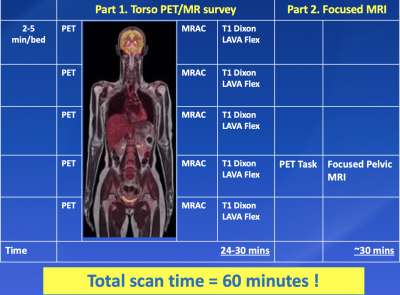 |
128 | Hybrid Rectal Multiparametric F18-FDG PET/MR in Restaging Locally Advanced Rectal Cancer: An initial experience
Mark Sugi, MD, Nitin Mishra, MD, MBBS, Jonathan Ashman, MD, PhD, Matthew Heller, MD, Yuxiang Zhou, PhD, Michael Roarke, MD, Ming Yang, MD
Rectal cancer is a leading cause of cancer death in the United States. Current standard of care in locally advanced rectal cancer includes chemoradiation therapy followed by surgical resection. Accurate radiological restaging therapy is essential for success of surgery. In this preliminary study, we investigated the synergistic role of rectal mpMRI and F18-FDG PET/MR in evaluation of response to therapy in advanced rectal cancer. Our data show promising added value of this “one-stop” imaging modality in providing complementary morphological and functional information in the detection of viable primary tumor as well as nodal and distal metastases, utilizing both MRI and PET molecular imaging biomarkers.
|
|
4329. 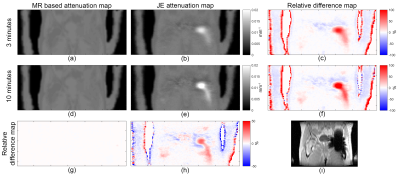 |
129 | Joint estimation of activity and attenuation using 68Ga-PSMA TOF PET/MR in patients with hip endoprosthesis
Edwin ter Voert, Sangtae Ahn, Florian Wiesinger, Kristen Wangerin, Ken Kudura, Urs Muehlematter, Irene Burger
Accurate PET attenuation correction remains challenging in PET/MR. Skeletal bone is usually not included and metal implants can cause serious artifacts. In this study we investigate the application of the ‘joint estimation of activity and attenuation’ PET reconstruction algorithm, using MR based priors, in prostate cancer patients with metal hip implants who were scheduled for 68Ga-PSMA TOF PET/MR. The results indicate that, even with the low background-signal of this tracer, the JE algorithm can recover most of the metal hip implant(s), thereby potentially improving the PET attenuation map as well as the activity images.
|
|
4330. 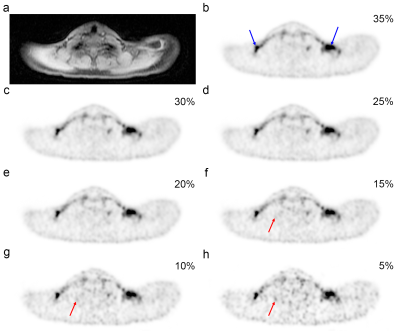 |
130 | Dose minimization in the detection of supraclavicular brown adipose tissue in 18F-FDG TOF-PET/MR: a simulation study
Edwin ter Voert, Julian Müller, Anton Becker, Balaz Miroslav, Vissarion Efthymiou, Claudia Maushart, Gani Gashi, Christian Wolfrum, Matthias Betz, Irene Burger
An increasing number of prospective trials are investigating the activity of brown adipose tissue (BAT) with 18F-FDG PET, in patients as well as in healthy volunteers. According to the Brown Adipose Reporting Criteria in Imaging Studies (BARCIST 1.0) the injected dose of 18F-FDG should be as low as possible, for statistically valid imaging, with consideration for total dosage in repeat studies. In our 18F-FDG TOF PET/MR simulation study we found that a minimum injected dose of 15MBq (0.29mSv) still allowed for accurate quantification of BAT activity, without a significant increase in noise or artifacts.
|
|
4331. 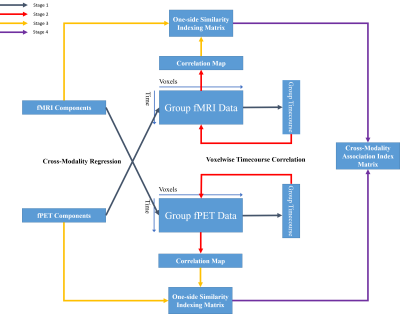 |
131 | Spatio-Temporal Association Between Simultaneously BOLD and FDG Resting State Networks
Shenpeng Li, Sharna Jamadar, Phillip Ward, Malin Premaratne, Gary Egan, Zhaolin Chen
The slow-infusion-based dynamic FDG-PET have demonstrated excellent sensitivity to glucose uptake in the brain. Using fPET which contains unprecedented temporal information, we introduce a cross-modality spatiotemporal regression method to measure the association of resting net works (RSNs) between simultaneously acquired fMRI and fPET datasets. By projecting both temporal and spatial information in RSNs from two modalities into the proposed cross-modality association index, several associated networks have been identified by the proposed method.
|
|
4332. 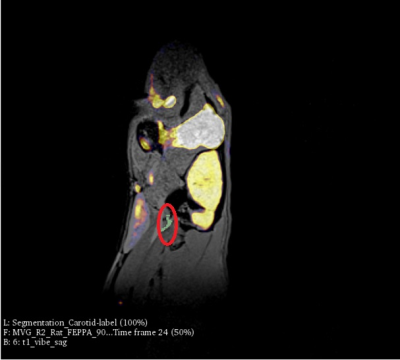 |
132 | A Carotid Artery Image-Derived Input Function for Pre-Clinical Simultaneous PET/MRI
Michael Van Ginkel, Matthew Fox, Qi Qi, Haris Smailovic, Frank Prato, Jonathan Thiessen
Using the carotid arteries for the extraction of an image-derived input function for kinetic modelling in rats.
|
|
4333. 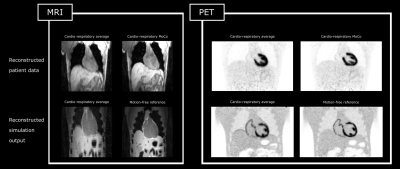 |
133 | Flexible Numerical Simulation Framework for Dynamic PET-MRI
Johannes Mayer, Kris Thielemans, Richard Brown, Evgueni Ovtchinnikov, David Atkinson, Paul Marsden, Tobias Schäffter, Christoph Kolbitsch
A numerical simulation framework for dynamic simultaneous PET- MR is presented, which allows for simulated data acquisition of different anatomy with cardiac and respiratory motion and dynamic contrast changes (due to MR contrast agent or PET tracer changes over time). The output of the simulation framework is provided in ISMRMRD and PET interfile raw data format and can be directly used in a range of available reconstruction packages. The reconstructed PET and MR images of the simulated data were compared to an in-vivo patient scan demonstrating that the simulation framework yields realistic data.
|
|
4334. 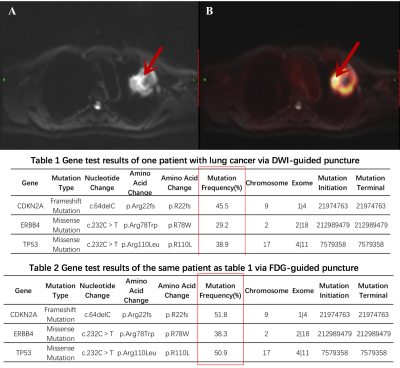 |
134 | The Value of PET/MR Multimodality Imaging in Assessing Intratumoral Biological Heterogeneity in Patients with Lung Cancer
Peng Yu, Jing Ning, Jing Li, Xiao Zhang, Yueyong Xiao, Mu Lin, Xiang Feng, Jiajin Liu, Baixuan Xu, Jiahe Tian
Lung cancer is characterized by high intra-tumoral heterogeneity, which potentially increases the difficulties of obtaining accurate biopsy results. By combining CT guided-biopsy of lung masses with previously acquired PET/MR images, we investigated the pathological statuses and gene mutation of tissues samples from different locations within one tumor. The results demonstrated that PET/MR can increase the accuracy of a biopsy as well as enhance our understanding of the complicated biological behaviors of cancers.
|
|
4335. 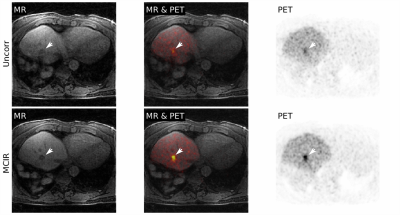 |
135 | Motion-corrected simultaneous DCE-MRI and PET for hepatic lesion assessment
Christoph Kolbitsch, Matteo Ippoliti, Marcus Makowski, Winfried Brenner, Tobias Schaeffter
Dynamic contrast enhancement (DCE) MRI is an important clinical imaging tool to characterize hepatic tumors. Especially in combination with PET imaging data, it has been shown to improve diagnostic confidence compared to PET/CT. Nevertheless, respiratory motion is still challenging, requiring multiple breathholds and leading to low scan efficiencies for PET and MR. Here we present a motion-corrected simultaneous DCE-MRI/PET approach which enables imaging with 100% scan efficiency using all data, to improve PET quantification and accurate alignment between both modalities. The proposed technique was evaluated in three patients with hepatic lesions showing an increased contrast-to-noise-ratio of PET tracer uptake by more than 80%.
|
|
4336. 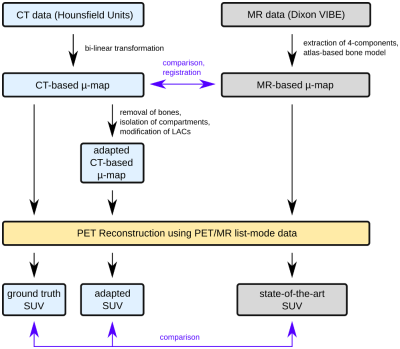 |
136 | Performance analysis and optimization of MR-based attenuation correction in hybrid PET/MR
Katharina Schröder, Harald Quick, Marcel Gratz
The recent approach of MR-based attenuation correction in hybrid PET/MR, using a Dixon-VIBE based 4-component µ-map along with an atlas-based bone model, was analysed regarding its accuracy and potentials to reduce deviations from the ground truth. Various CT-based µ-maps were synthesized and the influence of each component on the standardized uptake values was determined for 16 patients. Furthermore, the generated µ-maps were quantitatively compared to the original PET/MR-based µ-maps. It was demonstrated that an adjustment of the lung values and introduction of a second tissue compartment increases the accuracy of the calculated standardized uptake values, particularly for heart and abdomen.
|
|
4337. 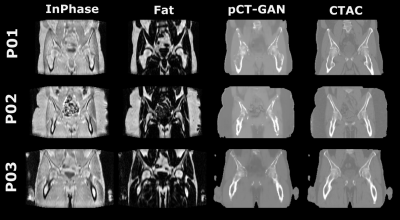 |
137 | GAN based continuous pseudo-CT computation for PET/MR attenuation correction and MR-guided radiation therapy planning
Sandeep Kaushik, Dattesh Shanbhag, Andrew Leynes, Cristina Cozzini, Anuprriya Gogna, Peder Larson, Florian Wiesinger
Generation of pseudo CTs from MR images is of interest for applications such as PET/MR attenuation-correction (AC) and MR-guided radiation therapy planning (MRgRTP). In this work, demonstrate a DL method that harnesses the style transfer capability of GAN to compute qualitatively and quantitatively accurate continuous density bone pCT images from Dixon based LAVA-Flex MRI sequence which has a short acquisition time. The method is evaluated for PET/MR attenuation correction.
|
|
4338. 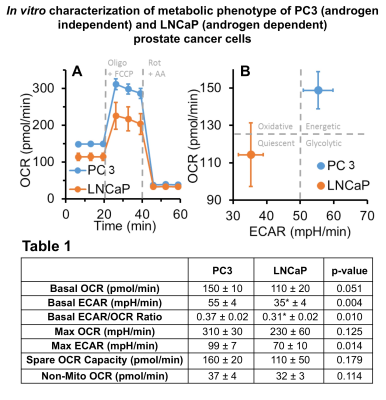 |
138 | Metabolic Modulation for Enhanced Therapeutic Response
Kavindra Nath, Stepan Orlovskiy, Jeffrey Roman, David Nelson, Dennis Leeper, Paul Smith, Mary Putt, Vivek Narayan, Jerry Glickson
SYNOPSIS: Metastatic prostate cancer is treated with androgen deprivation therapy (ADT), which involves the maximal suppression of circulating testosterone. Although initial responses are generally favorable, most cases progress to metastatic castration resistant prostate cancer (mCRPC), which is refractory to standard ADT. Our goal is to develop a treatment strategy to improve response of mCRPC by combining a clinically utilized metabolic modulator, AZD3965, with docetaxel. AZD3965 effects were measured in vivo by 31P and 1H MRS in PC3 prostate cancer xenografts. In vitro results suggest that AZD3965 enhances the growth inhibitory effect of docetaxel similarly both in PC3 and LNCaP cells although PC3 expresses both MCT1 & 4 and LNCaP only expresses MCT1.
|
|
4339 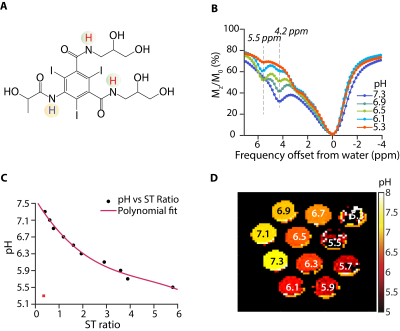 |
139 | CEST pH Imaging as a Diagnostic for Chronic Kidney Disease in Methylmalonic Acidemia (MMA) Video Permission Withheld
KowsalyaDevi Pavuluri, Irini Manoli, Alexandra Pass, Yuguo Li, Hilary J. Vernon, Charles P. Venditti, Michael T McMahon
Chronic Kidney Disease (CKD) is a serious complication of methylmalonic acidemia (MMA), manifests with proximal tubular dysfunction, tubulointerstitial nephritis, and eventually decreased glomerular filtration. Routine diagnostic tests, like serum creatinine, leave much to be desired. In this study, we designed an alternative MRI strategy to measure renal perfusion and create pH maps after administering iopamidol, a pH sensitive contrast agent. We detected robust differences in perfusion fraction and pH maps between severe, mild and no renal disease in MMA mouse model. These results demonstrate that MRI may facilitate early detection of kidney disease.
|
|
4340. 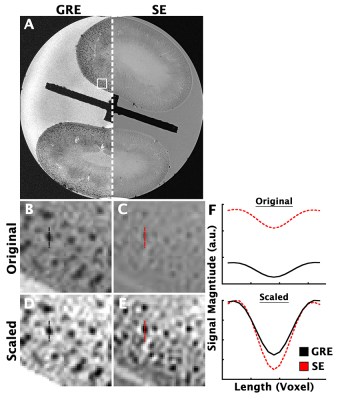 |
140 | A Static Susceptibility Model for MR Images Enhanced by Targeted Magnetic Nanoparticles to Accurately Measure Glomerular Volume in Rat Kidneys
Edwin Baldelomar, Kevin Bennett
It is believed that under nephron loss, remaining nephrons compensate by undergoing hypertrophy to maintain a constant filtration surface area and thus maintain homeostasis in GFR. Yet, there are no tools in the clinical setting to measure nephron endowment or glomerular size distribution. Here we used CFE-MRI, a good indicator of nephron number, and a classical model of static susceptibility to accurately measure glomerulus size in the kidneys of rats.
|
|
4341. 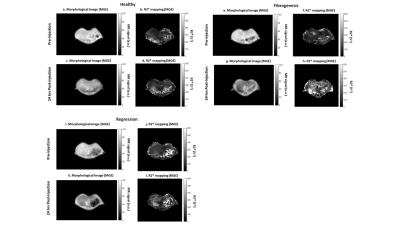 |
141 | Ultrasmall iron oxide particle-enhanced MR imaging of fibrogenesis and fibrolysis of liver fibrosis in mice
Joao Piraquive, Sabrina Doblas, Bich-Thuy Doan, Philippe Garteiser, Bernard E. Van Beers
The aim of our study was to assess if hepatic fibrogenesis and fibrolysis could by differentiated with USPIO-enhanced MR imaging in mice, based on differential uptake of fluorescent USPIO by macrophages. The change in R2* were significantly higher in the fibrogenesis group compared to the healthy group and the regression group 24 hours after the injection of USPIO. Higher USPIO uptake was observed with fluorescence microscopy during fibrogenesis relative to uptake in fibrolysis and healthy livers. Significant correlation was found between R2* and fluorescence intensity. These results suggest that the dynamics of fibrogenesis can be assessed with USPIO enhanced MR imaging.
|
|
4342. 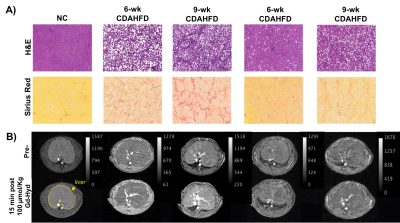 |
142 | Imaging response to Elafibranor treatment in a rat model of non-alcoholic steatohepatitis non-invasively by oxidized-collagen molecular MRI
Veronica Clavijo Jordan , Iris Zhou, Nicholas Rotile, Noah Warner, Eman Akam, Gunisha Arora, Smitha Krishnan, Christian Farrar, Alana Ross, Bryan Fuchs, Peter Caravan
Elafibranor is a dual agonist of the peroxisome proliferator-activated receptor-? and δ (PPAR-? and δ) in Phase III clinical trials for treatment of non-alcoholic steatohepatitis (NASH). Here, we evaluated the drug’s effectiveness in a choline-deficient high fat diet (CDAHFD) NASH model by imaging oxidized collagen as a marker for fibrogenesis in the liver using a Gd-based probe and MRI. Oxidized collagen MRI of the liver showed that Elafibranor successfully reduced fibrogenesis in rats with histologically-confirmed NASH, ex-vivo total collagen quantification by hydroxyproline assay, and histology staining, also confirmed the anti-fibrotic effect of Elafibranor in the CDAHFD-induced NASH model.
|
|
4343. 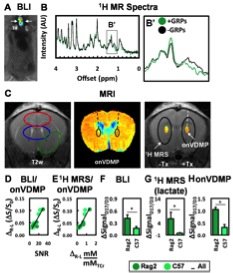 |
143 | Evaluation of Location-Dependent Attenuation of Experimental Autoimmune Encephalomyelitis after Glial-Restricted Progenitor Transplantation using CEST MRI and MRS
Aline Thomas, Shen Li, Chengyan Chu, Irina Shats, Jiadi Xu, Peter Calabresi, Peter van Zijl, Piotr Walczak, Jeff Bulte
The utility of CEST MRI and MRS as a noninvasive strategy for visualizing and tracking glial-restricted progenitor cells (GRPs) after transplantation was evaluated. GRPs increased signal in on-resonance variable delay multiple pulse (onVDMP) chemical exchange saturation transfer (CEST) MRI maps and 1H MRS at the lactate peak in cell phantoms, in naïve mice, and in an experimental autoimmune encephalomyelitis mouse model of multiple sclerosis at and/or proximal to the initial location of cells.
|
|
4344. 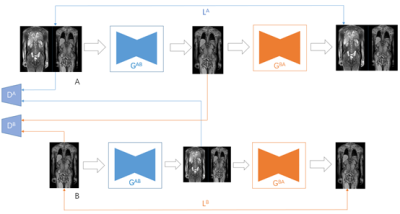 |
144 | Approaching the suppression of arm truncation artifact on 18F-FDG-PET/MR attenuation correction map: a feasibility study on MR image synthesis from cycle-GAN Presentation Not Submitted
Haojun Yu, Hui Liu, Shuguang Chen, Tuoyu Cao, Yiqian Zhang, Lingzhi Hu, Hongcheng Shi
Arm truncation artifact in PET/MR system was introduced by 1) smaller MR FOV to cover subject’s arm and 2) distorted gradient encoding at the boundary of FOV. PET imaging normally has larger FOV and non-distorted property. In this study, a cycle-GAN model trained with paired inputs of A (PET + pseudo-truncated-MR images) and B (pseudo-none-truncated-MR images) was proposed to synthesize none-truncated-MR images from PET and real-truncated-MR images then used for the generation of attenuation correction map. PET/MR whole body images from 10 patients were used for this feasibility evaluation. The cycle-GAN model was able to synthesize none-truncated-MR images for patients either with partial-arm covered or with distortion artifact in arm region.
|
|
4345. 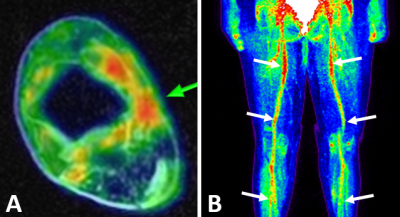 |
145 | Neurovascular, muscle, and skin changes on [18F]FDG PET/MRI in foot complex regional pain syndrome (CRPS)
Daehyun Yoon, Yingding Xu, Peter Cipriano, Vivianne Tawfik, Catherine Curtin, Ian Carroll, Sandip Biswal
Complex regional pain syndrome (CRPS) is a devastating chronic pain condition affecting 50,000 new patients every year in the U.S. Unfortunately, conventional methods for examining musculoskeletal damage such as physical exam or electrodiagnostic methods are very difficult to use for CRPS patients due to their extreme sensitivity to pain. In this abstract, we demonstrate the feasibility of [18F]FDG PET/MRI for investigating musculoskeletal changes from CRPS. Our results show the improved sensitivity of [18F]FDG PET to muscular, neurovascular, and skin changes over MRI, suggesting that [18F]FDG PET/MRI can be a valuable tool to monitor the pathologic process of CRPS.
|
|
4346. 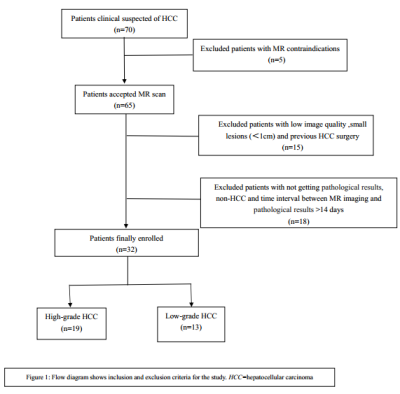 |
146 | Diagnostic Performance of Amide Proton Transfer-Weighted MRI for Predicting Histological Grade of Hepatocellular Carcinoma
Yue Lin, Chunmei Li, Jinyuan Zhou, Min Chen
Amide proton transfer-weighted (APTw) MR imaging has attracted increasing attention in the field of molecular imaging as a novel contrast mechanism in MRI. The purpose of the study was to prospectively evaluate the potential role of APTw-MRI and morphologic features in predicting the histological grade of hepatocellular carcinoma (HCC). We enrolled 32 HCC patients who underwent routine liver sequences and APTw sequence on a 3.0-T MRI scanner. Our results showed higher APTw values and larger tumor size are potential predictive biomarkers for high-grade HCC.
|
|
4347. 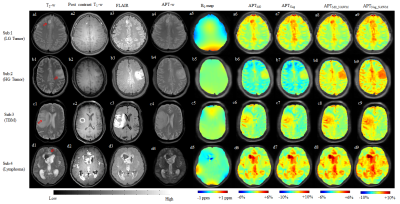 |
147 | To evaluate the role of APT-w contrast, optimized for normalization and ROIs selection, in differentiating Infective and Neo-plastic Mass Lesions
Ayan Debnath, Rakesh Gupta, Dinil Sasi, Snekha Thakran, Anup Singh
Differentiation of intra-cranial-mass-lesions (
|
|
4348. 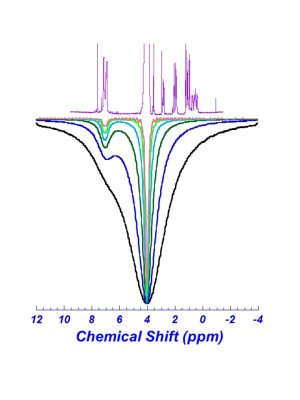 |
148 | Measuring J-coupling Mediated CEST for Desmosine, a critical amino acid for lung physiology and pathology
Jesse Roberts, Christian Farrar , Iris Zhou, Leo Cheng
Chemical Exchange Saturation Transfer (CEST) imaging provides the opportunity for probing important metabolic pathways in vivo. However, clinical implementation of the CEST method for metabolic imaging requires overcoming several technical obstacles. To advance the clinical application of this technology, we propose to generate the CEST effects of labile protons that are polarized via J-couplings by neighboring aliphatic protons while the latter undergo radio frequency irradiation. We tested and proved this concept using desmosine, a unique, pyridinium-containing amino acid that is critical for lung physiology and pathology. Additional work will be concentrated on further systematic investigations and in vivo implementations.
|
|
4349. 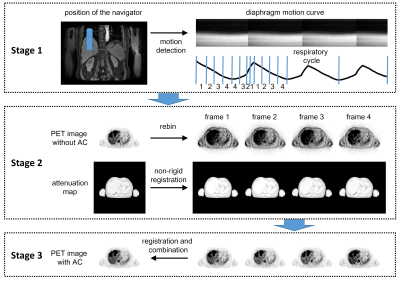 |
149 | A navigator-guided novel motion correction method in simultaneous PET/MR abdominal imaging
Lin Qiu, Wujian Mao, Yuhang Shi, Tuoyu Cao, Lingzhi Hu, Tao Feng, Hongcheng Shi
Simultaneous PET/MR abdominal imaging suffers from respiratory artifacts which causes motion blur of the PET images, further affecting clinical diagnosis. To eliminate motion blur, the work presents a novel PET image motion correction method by optimizing attenuation maps with navigators. The method significantly improves the image quality as well as the work flow and demonstrates its clinical value in detecting lesion in the liver.
|
|
4350.  |
150 | In vivo monitoring of Mesenchymal Stem Cells in a rat knee with Tissue Saturation SWIFT
Sergey Magnitsky, Michael Garwood, Nancy Lane, Djaudat Idiyatullin
Mesenchymal Stem Cells (MSCs) have potentials to be used for the treatment of bone diseases. We developed a new MRI method for detection of Fe-labeled MSCs. This protocol utilizes a resonance frequency shift induced by iron-oxide particles and allows imaging of grafted MSCs with a saturated signal from the host tissue. We compared retention of control and MSCs tagged with a high affinity to the bone tissue peptide. As compared with control, more tagged MSCs were detected at the injection area nine days after implantation. The new protocol allows
|
Digital Poster
| Exhibition Hall | 16:45 - 17:45 |
| Computer # | |||
4351.  |
151 | MR Visualization of Macrophages’ Damage in Response to X-Irradiation by Detecting Intracellular SPIO Deposition
Masayuki Yamaguchi, Kazunobu Ohnuki, Kenji Hotta, Hirofumi Fujii
The MR visualization of radiation treatment margins may be helpful during radiotherapy for liver cancer to monitor early response of the tumor and acute damage in non-tumor liver parenchyma. To demonstrate that MR signals from SPIO-labelled Kupffer cells may be changed in direct relation to the cellular response to x-irradiation, we examined the changes in transverse relaxation rates, R2’ (R2’=R2*-R2) of cell phantoms containing SPIO-labelled and x-irradiated macrophage-like J774A.1 cells in vitro. We found that x-irradiation to macrophages can cause SPIO deposition and R2’ elevation in a dose range of 0 to 10 Gy.
|
|
4352. 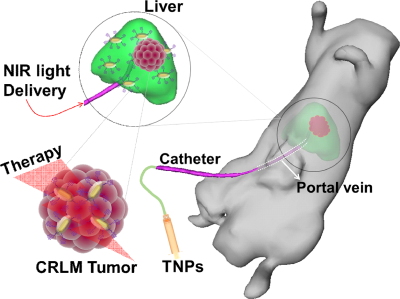 |
152 | Tracking nanoparticle mediated colorectal cancer liver metastasis ablation therapy using R2* magnetic resonance imaging
El-Sayed Ibrahim, Abdul Kareem Parchur, Gayatri Sharma, Jaidip Jagtap, Christopher Hansen, Venkateswara Gogineni, Peter LaViolette, Michael Flister, Sarah White, Amit Joshi
We developed sub-100nm optical/MR/X-ray contrast-bearing theranostic nanoparticles (TNPs) based on Gold nanorod cores and Gd3+ oxide shells for interventional image-guided photothermal therapy (PTT). In this study, we explore the value of MRI for tracking TNP-mediated PTT response and distinguishing tumors from normal surrounding tissues in preclinical colorectal liver metastases (CLRM). The results showed that tumors with TNPs depict higher R2*-relaxivity compared to normal liver post-TNP mediated PTT, and this increase persists ten days post-therapy. Therefore, MRI contrast can be used for specifically targeting CRLM tumors, which enables delivering sufficient amount of light to the tumor and tracking the therapy response.
|
|
4353. 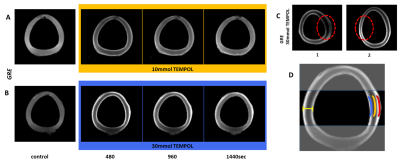 |
153 | Statistical Assessment of Nitroxide Radicals by T1-weighted Dynamic MRI in ex-vivo Porcine Aortic wall
Mihaela Pali, Anja Schroeder, Franziska Veit, Sebastian Kress, Heiko Walles, Maxim Terekhov, Laura Schreiber
Atherosclerosis genesis is attributed to a breakdown of homeostatic mechanisms undergoing increased oxidative stress followed by inflammation with extension to all aortic layers. Nitroxide radicals (NR) have been used as a redox-sensitive T1 contrast agent in NMR studies. Previous results have demonstrated assessment of exogenous induce redox state by using NR. In this study, we statistically assess the kinetics of NR-induced T1-weighted contrast in the ex-vivo porcine vascular wall. The results demonstrate persistence of the key values of NR induced T1-contrast kinetics and allow stepping further to quantitative assessment of the redox state within the vascular wall.
|
|
4354. 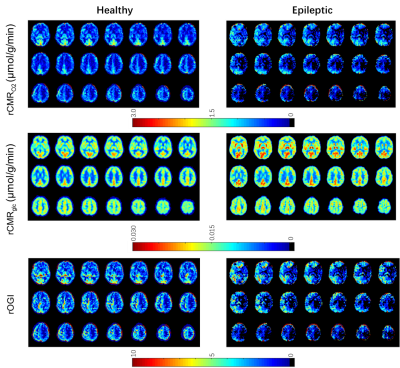 |
154 | Calibrated fMRI as a Complementary Diagnostic Method for Epilepsy
Qikai Qin, Miao Zhang, Peng Huang, Wei Liu, Hongping Meng, Biao Li, Bomin Sun, Mu Lin, Zheng Wang, Raymond Stevens, Garth Thompson
Epilepsy, one of the most common neurological disorders, is a chronic and recurrent disorder of the brain characterized by unprovoked seizures. Unfortunately, conventional diagnostic methods are limited due to the difficulties of precise localization of the epileptogentic zone. Here, we introduce the calibrated functional MRI (fMRI) to calculate the oxygen to glucose index (OGI) with a combined PET/MR system. With this approach we were able to observe large decreases in relative OGI within the affected hemisphere of epileptic patients. Our method, if proven to locate epileptic foci better than glucose-PET methods alone, will represent an important new diagnostic tool for epilepsy.
|
|
4355. 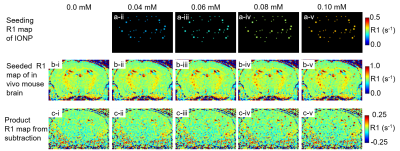 |
155 | Potential strategies to test the sensitivity of iron oxide nanoparticles as a spin-lattice MR relaxation contrast agent in vivo.
Joong Kim, David Brody
A well designed MR T1 relaxation contrast agent would provide readily detectible MR image contrast without extensive post-processing and superior spatial resolution compared to other MRI derived biomarkers. However, developing effective an T1 contrast agent would require comprehensive in vivo preclinical study. Thus, it would be highly beneficial to have methodology which can provide quantitative assessment on the relaxation effects of the employed contrast agent on living tissue without damaging the tissue integrity. Here we present a potential strategy to test MR sensitivity on T1 contrast agent on living tissue. The digital simulation provided quantitative assessment on T1 relaxation effect.
|
|
4356. 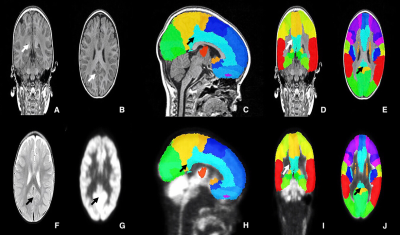 |
156 | Qualitative and quantitative morphology/metabolism analysis of infantile spasms using PET/MR and efficacy evaluation of ACTH therapy
Haodan Dang, Jiajin Liu, Honghong Liu, Liping Zou, Xiang Feng, Mu Lin, Jiahe Tian, Baixuan Xu
This study aimed to investigate the diagnostic performance of positron emission tomography/magnetic resonance imaging (PET/MR) for structural/metabolic abnormality in infantile spasms. We evaluated both the morphology and parameters of PET/MR images by qualitative and quantitative assessment. Our results showed quantitative analysis of PET/MR images could improve the diagnosis of etiologic abnormality. Furthermore, the classification of etiology using PET/MR can indicate the efficacy of adrenocorticotropic hormone (ACTH) treatment and provide valuable information for surgery plan.
|
|
4357.  |
157 | Investigation of halo-artifacts using improved scatter correction in 68-Ga-PSMA PET/MRI of the prostate
Maike E Lindemann, Axel Wetter, Nika Guberina, Bjoern Jakoby, Harald H Quick
A potential challenge of using radiotracer 68-Ga-PSMA for detection and staging of prostate cancer in PET/MR is a frequently observed halo-artifact around the urinary bladder caused by improper scatter correction (SC). Tumor manifestations in these regions might be non-detectable or show distorted SUVs. To evaluate the impact of SC on 68-Ga-PSMA PET/MR imaging, PET data sets of 100 patients were reconstructed twice using standard and improved SC. The improved SC significantly reduces the halo-artifact around the bladder. Measured SUVs in the halo margin on average increased by 325 %, and therefore, considerably affect quantitative assessment of prostate cancer in PET/MR.
|
|
4358. 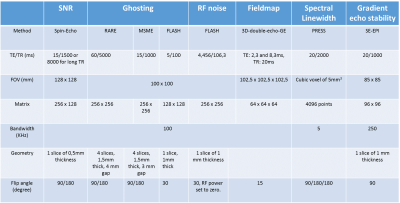 |
158 | Characterization of preclinical PET insert for 7T: beyond NEMA testing.
Willy Gsell, Cesar Molinos, Carlos Correcher, Sven Junge, Michael Heidenreich, Uwe Himmelreich, Christophe Deroose, Antonio Gonzalez
While we already reported indexes of the performance of one of the first commercially available SiPM-based MR-compatible PET Insert, no NEMA testing has been reported until now. Moreover the NEMA protocol for evaluating the performance of preclinical PET scanner, do not cover the integration and potential interference between PET and MRI. We hereby propose and report an extended NEMA protocol demonstrating the performance of the MRI (Biospec USR 70/30) with and without the presence of the PET Insert as well as the performance of the PET with simultaneous MRI acquisition.
|
|
4359. 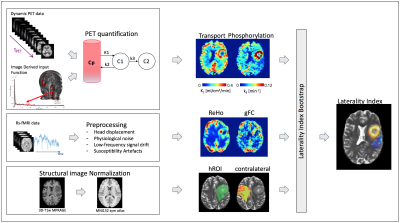 |
159 | Simultaneous PET/MRI to detect brain tumour metabolic and functional heterogeneity
Erica Silvestri, Marco Castellaro, Alessandro Palombit , Silvia Facchini, Elena Monai, Domenico D'Avella, Alessandro Della Puppa, Diego Cecchin, Maurizio Corbetta, Alessandra Bertoldo
Demarcation for brain tumour neurosurgical resection is typically performed using Fluid Attenuated Inversion Recovery images hyperintensities. In this study, we investigated in glioma patients whether these hyperintensities represent structural alterations that are metabolically and functionally homogeneous using simultaneous measurements of quantitative 18-Fluoro-deoxyglucose PET and resting state functional magnetic resonance imaging. FLAIR hyperintense regions resulted to be heterogeneous both at metabolic and functional standpoint and only partially significantly altered when compared with contralateral homologous white matter. These results support the hypothesis that multi-parametric approaches might improve the outcome of brain surgery informing the resection procedure.
|
|
4360. 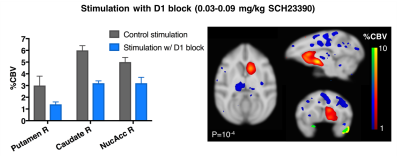 |
160 | Functional signaling contributions of D1 and D2 dopamine receptors during VTA stimulation in non-human primates
Christin Sander, John Arsenault, Bruce Rosen, Joseph Mandeville, Wim Vanduffel
Deep brain stimulation in the ventral tegmental area (VTA) has shown promise in modulating reward and learning. However, its underlying molecular mechanisms are still largely unexplored. In this study, fMRI and PET together with selective pharmacological blocking was used to distinguish dopamine receptor subtype-specific mechanisms of VTA stimulation in a non-human primate model with a chronically implanted stimulation electrode. Our results show that the main dopaminergic contribution to fMRI signal is likely driven by D1 receptor signaling, with a smaller D2 receptor contribution. Overall, this is a novel finding distinguishing dopaminergic receptor subtypes involved in VTA stimulation.
|
|
4361. 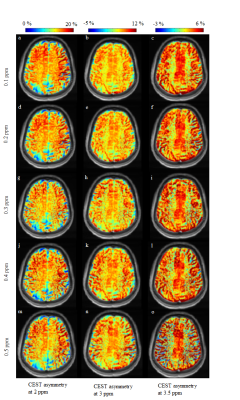 |
161 | Optimization of saturation frequency offset step size for CEST asymmetry contrast of human brain at 7T MRI
Ayan Debnath, Hari Hariharan, Ravi Prakash Reddy Nanga, Puneet Bagga, Dinil Sasi, Ravinder Reddy, Anup Singh
Chemical-exchange-saturation-transfer(CEST) MRI is being used for mapping molecular-information. CEST contrasts such as Creatine-weighted(frequency-offset=2ppm), Glutamate-weighted(frequency-offset=2ppm) and APT-weighted(frequency-offset=3.5ppm) are being explored for potential clinical applications. Computation of contrast(CEST-asymmetry) at a frequency-offset require data acquisition at multiple offset-frequencies either for B0-inhomogenity correction or generating z-spectra. Objective of this study was to evaluate the effect of sampling frequency-offset step-size (0.1, 0.2, 0.3, 0.4, 0.5ppm) on CEST-asymmetry contrast. Standard-deviation, coefficient-of-variation and normalized-mean-sum-squared-errors(nMSSE) increases while correlation decreases with increase in step-size. By considering both scan time and error, step-size of 0.2 to 0.3 is optimum for computing CESTasym.
|
|
4362. 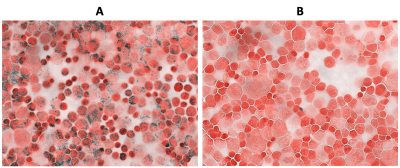 |
162 | Using iron oxides and perfluorocarbons with magnetic resonance imaging for simultaneous cell tracking of two populations in a model of stem cell rejection
Olivia Sehl, Ashley Makela, Amanda Hamilton, Paula Foster
Mesenchymal stem cells (MSCs) are a promising cellular therapeutic. However, this therapy is limited by MSC apoptosis following administration, which can ultimately trigger immune rejection. In this study we explored the ability to label, detect, and quantify both MSCs and infiltrating macrophages using both iron and fluorine-19 (19F) based MRI cell tracking. With a dual-tuned surface coil and a 3D bSSFP sequence, we demonstrated that both cell populations can be monitored during the same imaging session. This is the first study to image macrophage infiltration in vivo using 19F on a 3T clinical MRI system.
|
|
| 4363. |
163 | Evaluation of attenuation reduction of a dedicated carotid PET/MRI coil
S.M. Mueez Aizaz, Rik Moonen, Roel Wierts, Jochem van der Pol, Hans Zwart, Abe van der Werf, Joachim Wildberger, Jan Bucerius, M. Eline Kooi
Dedicated RF coils are required to acquire high resolution MR images. These RF coils are in the PET field of view in a PET/MRI scanner. Therefore, attenuation from these coils can cause bias in PET quantification. This study compares a newly developed dedicated PET/MRI RF coil with a coil designed for MRI-only. Both a phantom and patients injected with 18F-FDG were scanned with both coils and without a dedicated coil (baseline). Activity measured in the phantom was significantly reduced with the MRI-only coil compared to the new coil, which did not show any significant attenuation effect. Results in patients support this finding.
|
|
4364. 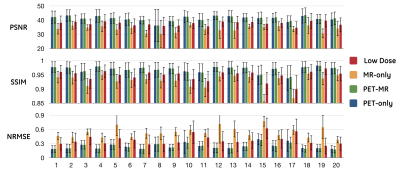 |
164 | Low Dose PET/MR Imaging in Crohn's Disease
Wei-Jie Chen, Christian Park, Po-Ling Loh, Scott Perlman, David Kim, Jessica Robbins, Alan McMillan
For patients with Crohn’s Disease, reduction of radiation exposure during imaging exams is critical as life-long surveillance is often required. This research aims to reconstruct full dose PET images from low dose and MR images using a deep learning approach. Based on the analysis in twenty patients utilizing Leave-One-Out-Cross-Validation, a 10x reduction from clinical FDG tracer dose is attainable.
|
|
4365. 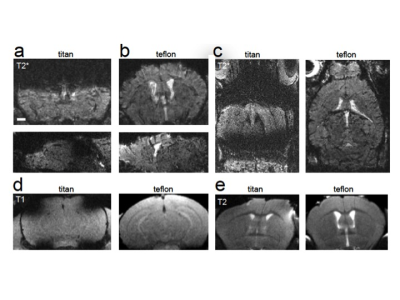 |
165 | Innate immune cell tracking in the glioma microenvironment by correlated magnetic resonance imaging and multi photon microscopy (MR-MPM)
Kianush Karimian-Jazi, Philipp Münch, Allen Alexander, Manuel Piechutta, Matthia Karreman, Gergely Solecki, Anna Berghoff, Wolfgang Wick, Sabine Heiland, Martin Bendszus, Michael Platten, Frank Winkler, Michael Breckwoldt
The tumor microenvironment (TME) plays a key role for tumor biology. Composition of the TME correlates with overall survival and governs therapy response. Non invasive assessment of the TME has been notoriously difficult. We have designed an imaging strategy to non invasively visualize innate immune cell dynamics in the TME by correlated MRI and multiphoton microscopy. This approach allowed us to visualize the single steps of nanoparticle uptake by blood born monocytes that give rise to tumor macrophages in an experimental glioma model. We further found that nanoparticle uptake also occurs via the disrupted blood-brain barrier into the brain parenchyma where NP are taken up by tumor associated microglia.
|
|
4366. 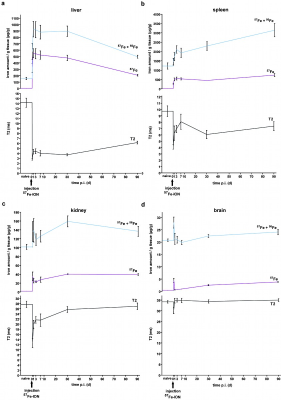 |
166 | Specific quantification of 57Fe-nanoparticles by combined MRI and Mass Spectrometric Imaging
Max Masthoff, Andre Beuker, Rebeccca Buchholz, Lydia Wachsmuth, Walter Heindel, Uwe Karst, Moritz Wildgruber, Cornelius Faber
Iron oxide nanoparticles (ION) provide high sensitivity for MRI cell tracking, but signal reductions cannot easily be separated from those originating from endogenous iron. We combine 57Fe-ION MRI with laser ablation-inductively coupled plasma-mass spectrometry for differentiation between endogenous iron (56Fe) and applied ION. We establish 57Fe-ION as contrast agent and assess their long-term fate. The technique facilitates specific and quantifiable cell tracking. ION were first internalized by phagocyting cells predominantly in liver and spleen, but in the long-term relocated to endogenous iron sources as the blood or red pulp of the spleen and, interestingly, also in the brain parenchyma.
|
|
4367. 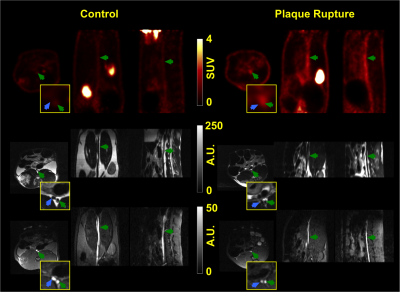 |
167 | In vivo detection and quantification of plaque rupture using a novel fibrin-binding PET tracer
David Izquierdo-Garcia, Himashinie Diyabalanage, Ian Ramsay, Nick Rotile, Adam Mauskapf, Ji-Kyung Choi, Thomas Witzel, Anna-Liisa Brownell, Ciprian Catana, Peter Caravan, Ilknur Ay
Detecting high-risk atherosclerotic plaques prone to rupture is still one of the main challenges in cardiovascular imaging that could help save many lives.
This study presents a novel fibrin-binding positron emission tomography (PET) radiotracer, 68Ga-CM246, which allows accurate detection and quantification of plaque rupture in an animal model of atherosclerosis using simultaneous PET/MRI. Our in vivo PET results show that 68Ga-CM246 is highly sensitive and very specific to fibrin clots in ruptured plaques. Our results confirm the potential of the 68Ga-CM246 to translate into the clinic to identify in humans those plaques at risk of rupture showing intraplaque hemorrhage. |
|
4368. 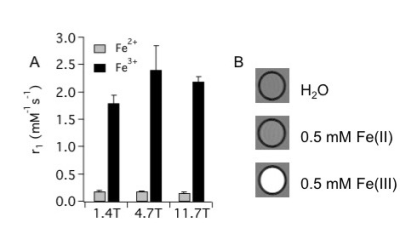 |
168 | Redox Active Iron Complexes as Biochemically Responsive MRI Contrast Agents.
Huan Wang, Ian Ramsay, Peter Caravan, Eric Gale
The redox active chelate Fe-PyC3A provides an order of magnitude change in relaxivity by switching between the weakly and strongly contrasting Fe(2+) and Fe(3+) oxidation states, respectively. This activatable relaxivity change is field independent between 1.4T and 11.7T, and far exceeds what is possible with Gd contrast agents. Oxidation state interchange is triggered by biochemical reductants and oxidants such cysteine and hydrogen peroxide. Redox active iron complexes offer a new paradigm for the design of biochemically responsive MRI contrast agents.
|
|
4369. 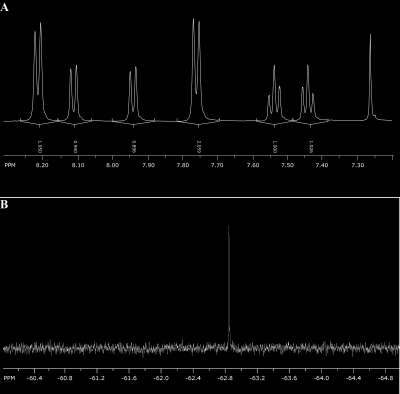 |
169 | Fluorine-19 (19F) Labeled Benzothiazole Derivative as a Biosensor for detection of Alzheimer’s Disease using Magnetic Resonance Imaging
Yurii Shepelytskyi, Michael Campbell, Francis Hane, Tao Li, Vitalii Solomin, Vira Grynko, Mitchell Albert
There are 5-7 million new cases of Alzheimer’s disease (AD) recorded each year worldwide. Typically, Positron Emission Tomography (PET) is used for the detection of amyloid b plaques allow for diagnosis of
|
|
4370. 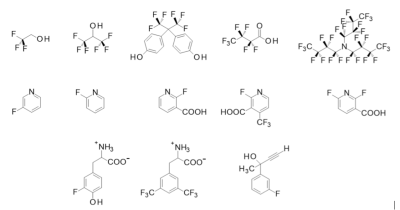 |
170 | Temperature Sensitive 19F-Substituted Molecules for Combined Proton-/Fluorine-Imaging in a 7 T Whole-Body MRI System
Christian Bruns, Markus Plaumann, Tim Herrmann, Frederike Euchner, Suchit Kumar, Rainer Ringleb, Johannes Bernarding
19F MR spectroscopy and imaging represent important tools for the development of new MR contrast agents and pharmaceutics. Until now, there are only a few published data that described the influence of temperature changes to the 19F chemical shifts in aqueous solutions. Temperature coefficients up to ~ 8.7Hz/K were determined. Thermoresponsive agents are of high interest in, e.g. hyperthermia studies. Changes in signal intensity and chemical shift give information of the local temperature. Here, we present novel MR spectroscopic and imaging data, which describe the 19F MR signal temperature dependency of different fluorinated organic substrates in isotonic saline solution and their temperature calculation methods.
|
|
4371. 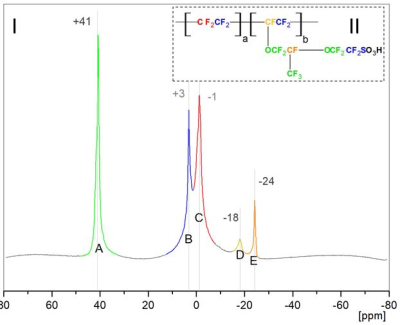 |
171 | Overcoming short T2 issue with the use of 3D UTE for imaging of 19F-loaded theranostic nanocapsules
Natalia Lopuszynska, Krzysztof Szczepanowicz, Wladyslaw Weglarz, Piotr Warszynski
The development of heteronuclear magnetic resonance imaging is one of the strategies in a control of a biodistribution of therapeutic agents. Molecules containing 19F atoms are particularly attractive for use as MRI markers due to favorable physical properties of fluorine nucleus. Advances in MRI instrumentation and ultrafast pulse sequence development expanded the range of fluorine compounds available as new MRI markers. Optimization of imaging parameters of such sequences enables the visualization of 19F compounds with the less preferable characteristic. In this paper, we report the application of the 3D UTE sequence at a high field for imaging of compounds with a complex 19FNMR spectrum and very short T2.
|
|
4372 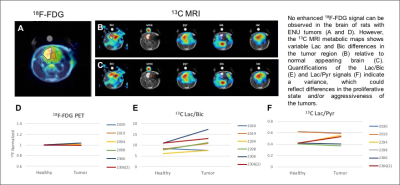 |
172 | Metabolic differences between hyperpolarized 13C pyruvate MRI and 18F-FDG PET imaging in a rat model of spontaneous brain cancer Video Permission Withheld
Mette Lauritzen, Keshav Datta, Milton Merchant, Taichang Jang, Ralph Hurd, Shie-Chau Liu, Lawrence Recht, Daniel Spielman
Hyperpolarized [1-13C]pyruvate MRI and 18F-FDG PET imaging signals were compared in a rat model of spontaneous slow growing glioma, which mimics the growth pattern of some human gliomas. No enhancement of 18F-FDG was observed in the tumor regions relative to normal appearing brain. Hyperpolarized 13C MRI however did show metabolic differences in all animals. The present study suggests that hyperpolarized 13C MRS potentially may be used to identify and characterize gliomas, which are 18F-FDG negative.
|
|
4373. 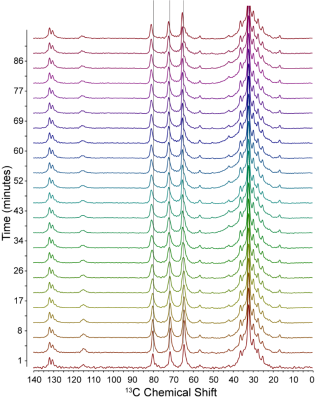 |
173 | Dynamic Imaging of Vitamin C Pharmacokinetics by 13C Chemical Shift Imaging without Hyperpolarization
Jeffrey Brender, Shun Kishimoto, James Mitchell, Murali Cherukuri
Intravenously injected vitamin C is re-emerging as a potential chemotherapeutic agent but questions remain about its bioavailability and metabolic fate. Using newly developed methods for signal denoising, we show that is possible to image vitamin C pharmacokinetics by non-hyperpolarized 13C MRI with significant sensitivity and time resolution that the accumulation of vitamin C into a tumor and its metabolism into downstream metabolites can be visualized. Since the method does not rely on hyperpolarization and therefore does not have restrictions on T1 relaxation, it can be potentially extended to other highly tolerated drugs.
|
|
4374. 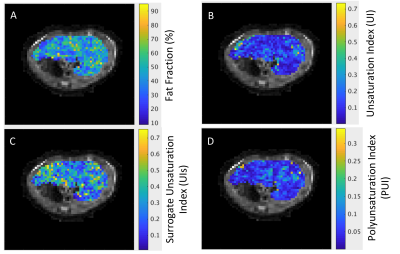 |
174 | Liver Fatty Acid Profile Mapping with Accelerated Free-Breathing Spectroscopic Imaging
Miriam Hewlett, Christa Davis, David McAllindon, Chris Bowen, Kimberly Brewer, Sharon Clarke, Steven Beyea, James Rioux
Fat composition in the liver, particularly the amount of polyunsaturated fat, may be important in characterizing NAFLD. Spatially resolved maps of unsaturation indices were generated using an accelerated free-breathing spin echo single point imaging technique. Multiple under-sampling patterns were acquired sequentially to ensure oversampling of the k-space centre even after retrospective motion correction. The technique was validated using a set of oil/water mixture phantoms and evaluated in an in vivo mouse study (N=8).
|
|
 |
4375. 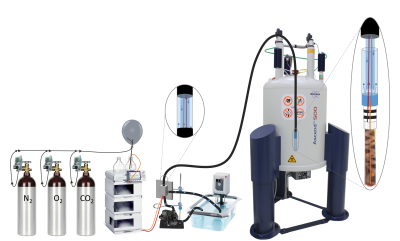 |
175 | Real-time Metabolic Investigations of Living Cells by NMR – First Experiences
Damian Hertig, Andrea Felser, Gaëlle Diserens, Sandra Kurth, Jean-Marc Nuoffer, Peter Vermathen
NMR approaches using flow systems for real-time spectroscopy of living cells were explored as early as the 80s but did not become routine due to different technical obstacles. We show the technical feasibility of real-time metabolic monitoring in 3D culture inside our established NMR bioreactor using the commercially available InsightCellTM (Bruker) tool, which supposedly eases bioreactor setup. Human skin fibroblasts showed reproducible glucose and O2 measurements in stop-and-go experiments over 12 hours. Chemical interventions on aerobic energy production pathways showed fast response by increasing rate of anaerobic glycolysis, which could be reversed by subsequent inhibition of glycolytic pathway.
|
 Back to Program-at-a-Glance |
Back to Program-at-a-Glance |  Back to Top
Back to Top